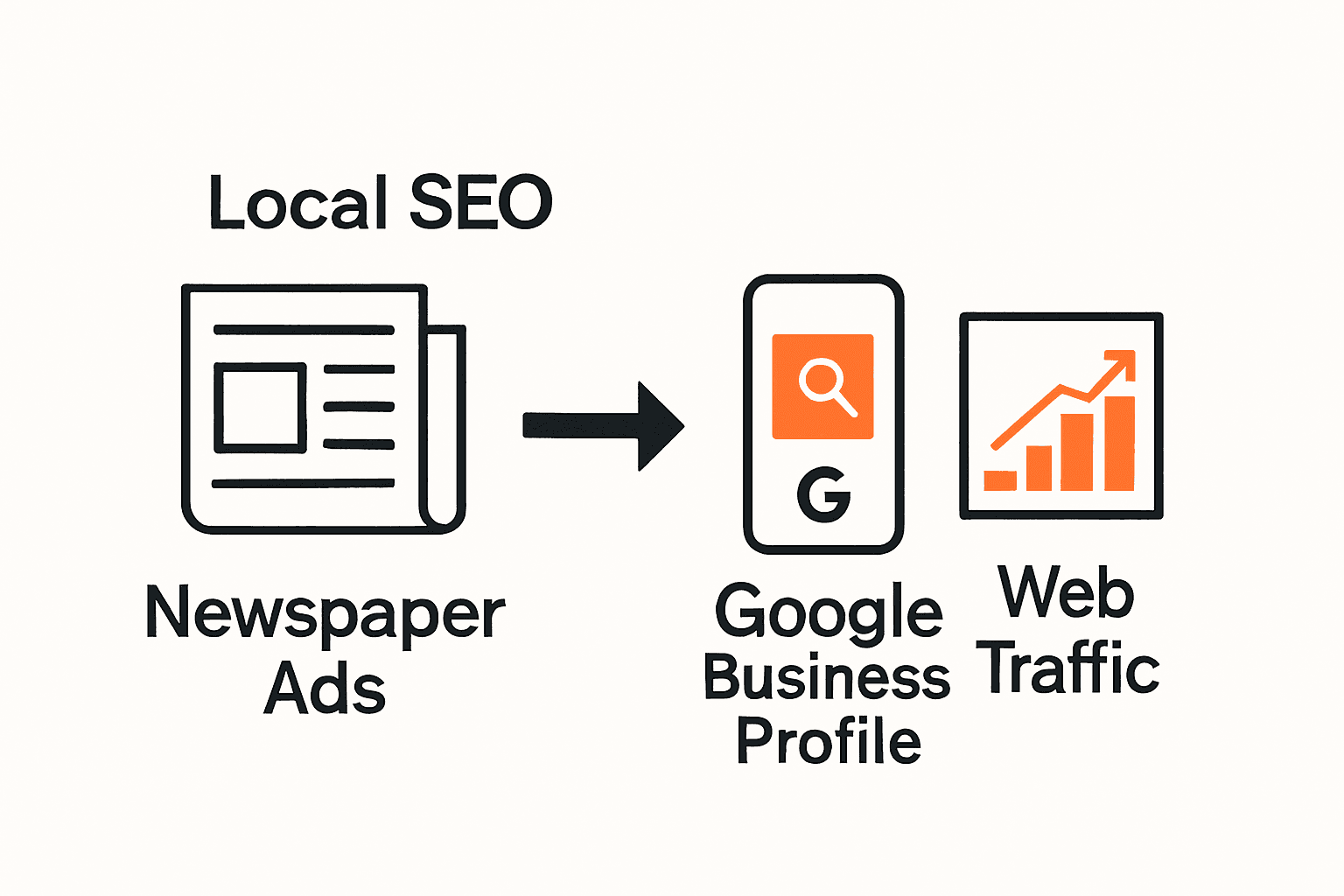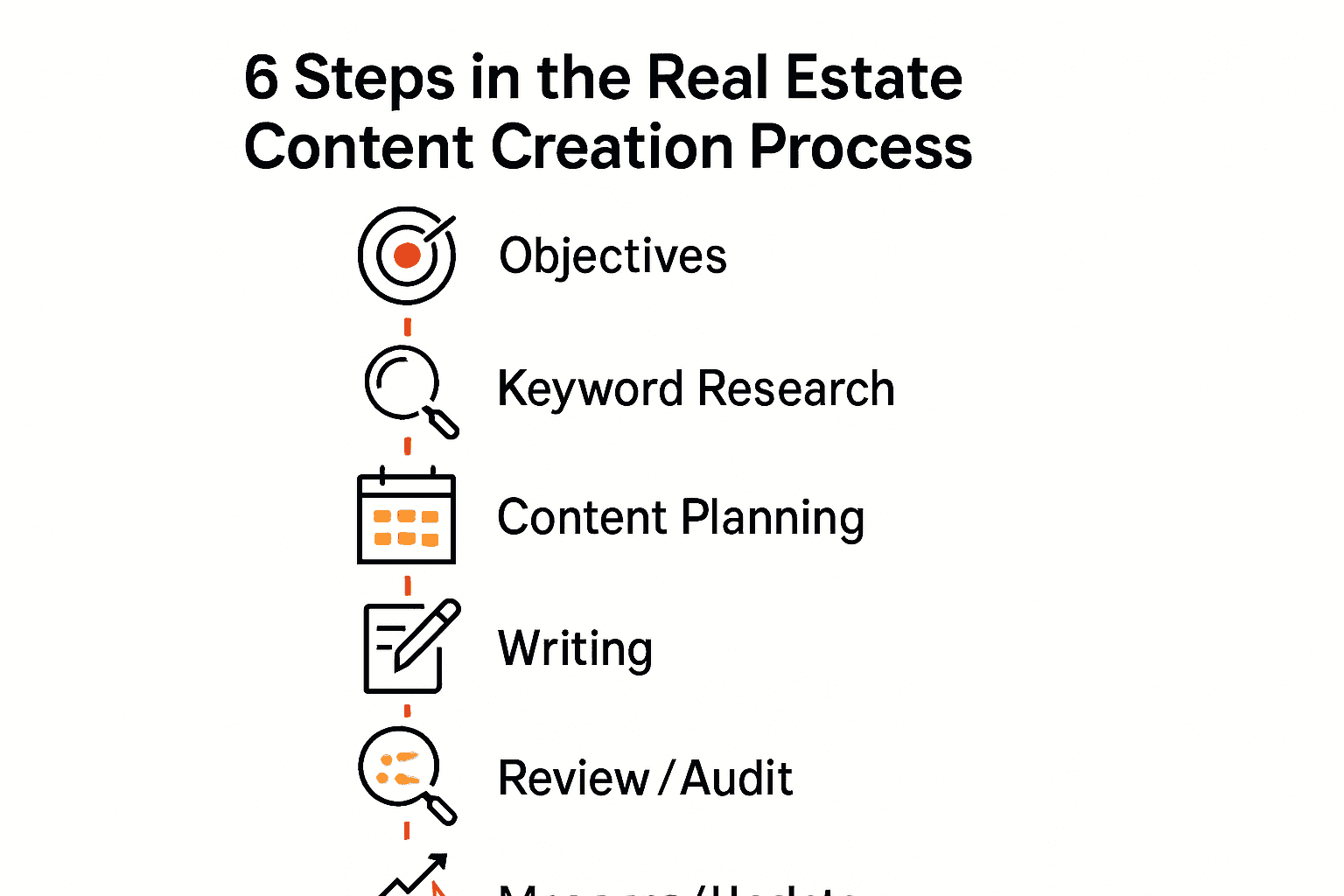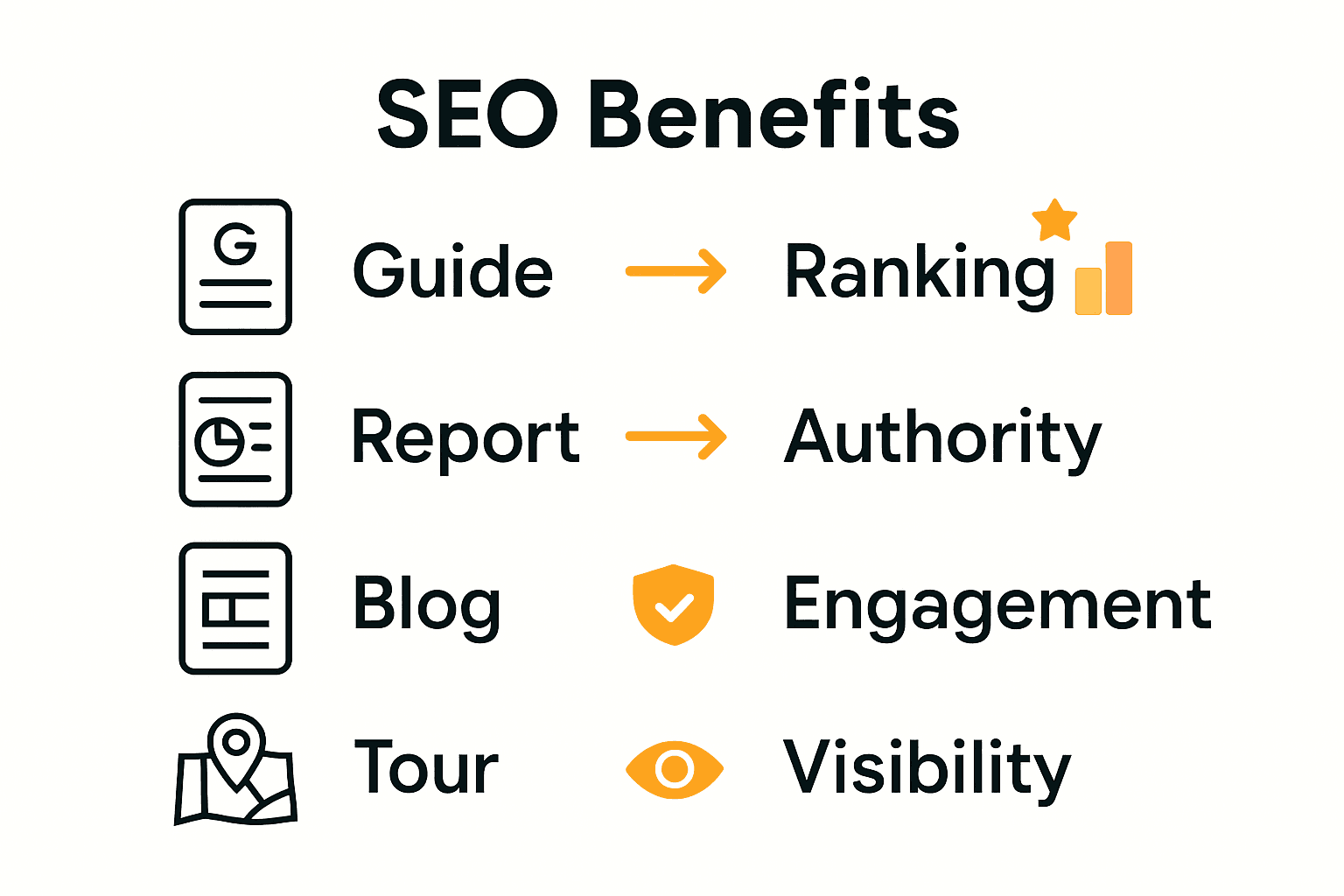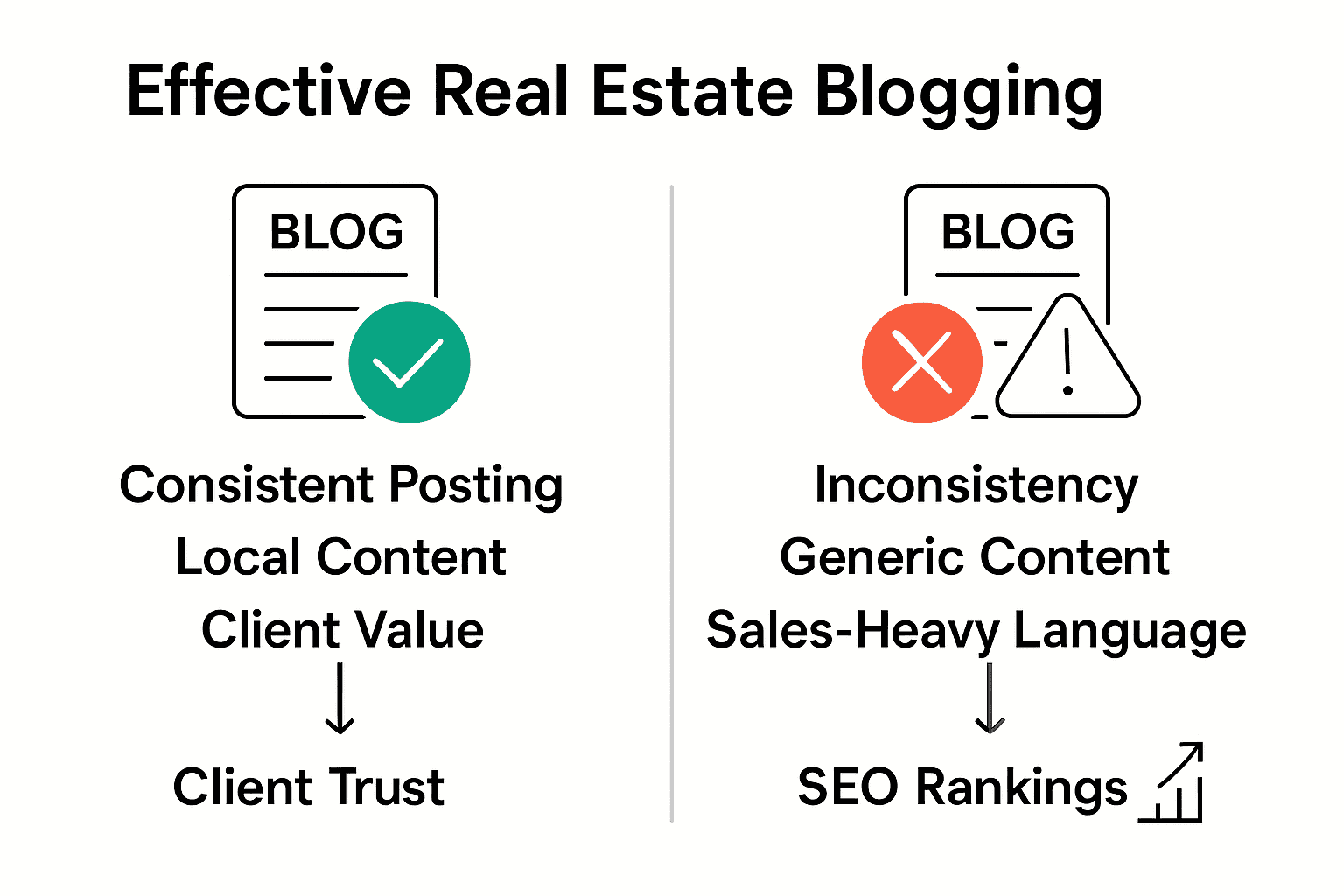- You are here:
- Home »
- Author's Archive:
All posts by Greg Reed

Lead Generation Workflow Real Estate: Step-by-Step Success
Did you know that over 90 percent of home buyers begin their search online? In a crowded real estate market, getting high quality leads makes all the difference for agents who want lasting success. Understanding who your ideal client is and how to reach them not only shapes your strategy but also determines how much value you deliver. Discover the steps to turn curiosity into solid connections and grow your business.
Table of Contents
- Step 1: Define Your Ideal Client And Market Focus
- Step 2: Set Up Essential Lead Capture Channels
- Step 3: Develop Compelling Lead Magnets And Offers
- Step 4: Implement Automation For Lead Nurturing
- Step 5: Track Results And Optimise Your Workflow
Quick Summary
| Key Point | Explanation |
|---|---|
| 1. Define Your Ideal Client | Understand your target audience and their specific needs to tailor your marketing strategies effectively. |
| 2. Set Up Lead Capture Channels | Create multiple engagement points like a professional website and optimize Google Business Profile for better visibility. |
| 3. Develop Compelling Lead Magnets | Design valuable offers that address specific problems of your target market to increase lead capture rates. |
| 4. Implement Automated Lead Nurturing | Use segmented email campaigns to provide personalized communication, enhancing client engagement throughout their journey. |
| 5. Track Performance and Optimize | Regularly analyze KPIs to refine your lead generation strategies and improve overall effectiveness in conversions. |
Step 1: Define your ideal client and market focus
Successful real estate lead generation starts with knowing exactly who you want to serve. According to Dataconomy, building trust through targeted content marketing requires a crystal clear understanding of your target audience and locality.
Begin by mapping out your specific market segment. Are you focusing on first time homebuyers in suburban areas? Luxury property investors? Retirees looking to downsize? Your target client profile determines everything from your marketing strategy to the properties you showcase.
Create a detailed client persona that goes beyond basic demographics. Think about their motivations, challenges, and aspirations. A young professional might prioritize proximity to public transport and modern amenities. A growing family will likely want school districts and spacious layouts. Understanding these nuanced preferences helps you craft more compelling communications.
Here’s a comparison of common real estate client personas and their unique needs:

| Client Persona | Key Motivations | Top Priorities |
|---|---|---|
| First-Time Homebuyer | Security Affordability |
Proximity to transit Modern amenities |
| Luxury Investor | ROI Status |
Prime locations Exclusive properties |
| Retiree Downsizer | Simplicity Accessibility |
Walkability Low maintenance |
| Growing Family | Space Stability |
Schools Safe neighborhoods |
Research your local market thoroughly. Examine recent sales data, neighborhood trends, and economic indicators. This helps you identify not just who your ideal clients are but where they are most likely to be searching for properties.
Pro Tip: Use local real estate data platforms and government statistics to build a comprehensive market understanding.
Once you have defined your ideal client, everything from your website copy to your social media content can be strategically tailored to speak directly to their needs and desires. Your marketing becomes more precise powerful and effective.
Ready to move to the next step? You will now develop a targeted content strategy that speaks directly to your defined market segment.
Step 2: Set up essential lead capture channels
Your lead generation strategy hinges on creating multiple touchpoints where potential clients can discover and engage with your real estate services. According to Dataconomy, successful real estate agents integrate diverse channels like CRM systems email platforms and social media to maximize lead capture opportunities.
Start by establishing a robust online presence through a professional website with clear contact forms. Your website should not just showcase properties but actively invite interaction. Implement strategic call to action buttons that make it easy for visitors to request more information schedule viewings or download market reports.
Expand your digital reach by optimizing your Google Business Profile. Inman highlights the importance of creating a searchable profile that appears in local searches. Include high quality property images comprehensive business information and encourage client reviews to boost your credibility.
Consider innovative capture methods beyond traditional websites. QR codes on property signage mailers or business cards can instantly connect potential clients to your landing pages. Create engaging YouTube videos about local property markets neighborhood guides and client testimonials that provide value while subtly capturing viewer contact details.
Pro Tip: Always offer something of genuine value in exchange for contact information such as a free market analysis report or exclusive property listing guide.
Develop a comprehensive CRM system that tracks interactions across all channels. This allows you to nurture leads systematically and personalize your communication based on their specific interests and interactions.
Ready for the next step? You will now learn how to craft compelling content that attracts and converts these captured leads into potential clients.
Step 3: Develop compelling lead magnets and offers
Lead magnets are your secret weapon for transforming casual website visitors into potential clients. According to LinkedIn, high converting lead magnets in real estate include homebuyer guides free property valuation PDFs and local moving resources that provide genuine value to potential clients.
Design your lead magnets with laser focus on solving specific problems your target market experiences. A first time homebuyer might appreciate a comprehensive guide walking them through the purchasing process. Investors could be drawn to a detailed market analysis report showcasing neighborhood property value trends. The key is creating content so useful that people willingly exchange their contact information to access it.
Inman suggests innovative approaches like QR code mailers linking to exclusive reports such as “7 Secrets That Make Owning a Home Easier” or unsolicited video comparative market analyses. These unexpected value offerings can dramatically increase your lead capture rates.
Consider multiple formats for your lead magnets digital PDFs video walkthroughs webinar recordings interactive property valuation tools. Diversifying your offerings increases the likelihood of attracting different types of potential clients with varying content preferences.
Pro Tip: Ensure your lead magnet directly relates to the specific needs of your ideal client persona you developed in the previous step.
Track the performance of each lead magnet.
 Some will resonate more strongly than others and understanding these nuances helps you refine your approach continuously.
Some will resonate more strongly than others and understanding these nuances helps you refine your approach continuously.
Ready for the next step? You will now learn how to create a systematic follow up process that converts these captured leads into actual clients.
Step 4: Implement automation for lead nurturing
Automation transforms how real estate agents manage and engage potential clients. According to Fran Funnel, effective lead nurturing requires strategic drip email campaigns precisely segmented by buyer personas ensuring consistent personalized communication throughout the client journey.
Start by designing targeted email workflows for different client segments. First time homebuyers will need educational content about purchasing processes. Investors require market trend analyses and investment property insights. Retirees might appreciate neighborhood lifestyle guides. Your automation should feel like a personalized conversation not a generic broadcast.
Zavops highlights the importance of multichannel automation beyond traditional email. Consider integrating SMS marketing which boasts significantly higher open rates and implementing click to call features on your website for immediate engagement.
Create a logical sequence of touchpoints that gradually build trust. Your first email might offer the free guide they downloaded. Follow ups could include neighborhood market reports community event invitations or personalized property recommendations based on their initial interaction.
Pro Tip: Set up triggered emails that respond instantly to specific lead actions like downloading a resource or clicking a particular link.
Track engagement metrics closely. Which emails get opened? What content generates the most clicks? Use these insights to continuously refine your automation strategy making each interaction more compelling than the last.
Ready for the next step? You will now learn how to convert these nurtured leads into actual client meetings and property transactions.
Step 5: Track results and optimise your workflow
Data drives success in real estate lead generation. According to Dataconomy, integrating comprehensive CRM systems allows agents to monitor lead interactions across multiple channels enabling precise performance tracking and strategic optimization.
Start by establishing key performance indicators specific to your lead generation workflow. Conversion rates cost per lead engagement levels and client acquisition metrics will be your north star. Track how many website visitors transform into actual leads and what percentage of those leads convert into signed clients.
ShareLoApp recommends analyzing performance across diverse channels. Examine metrics from content marketing social media advertising virtual tours and blog engagement. Which platforms generate the most qualified leads? Where are you seeing the highest return on investment?
Implement monthly review sessions where you deep dive into your analytics. Look beyond surface level numbers and understand the story behind the data. Are certain lead magnets performing better than others? Do specific email sequences generate more responses? Your workflow should be a living document constantly refined by real world performance.
Pro Tip: Create a dashboard that consolidates all your key metrics making it easy to spot trends and make rapid strategic adjustments.
Remember that optimization is an ongoing process. What works today might change tomorrow. Stay curious experiment regularly and be willing to pivot your approach based on solid data insights.
Ready for the final step? You will now learn how to continuously improve and scale your real estate lead generation strategy.
Elevate Your Real Estate Lead Generation with Content Charlie
The challenge of crafting a precise lead generation workflow that truly connects with your ideal client can feel overwhelming. This article highlights how defining client personas, creating compelling lead magnets, and automating nurturing processes are essential steps. Yet, without the right content strategy focused on local SEO and persuasive copywriting, even the best workflows may fail to capture and convert leads effectively.
At Content Charlie, we understand that your success depends on being discovered by motivated buyers and sellers right in your neighborhood. Our expertise lies in producing targeted real estate copy, suburb guides, and Google Business Profile content that ranks on Google and speaks directly to your defined market segment. Combine your strategic workflow with our high-converting content solutions to build trust, boost engagement, and turn prospects into clients.

Don’t let your leads slip away due to unclear messaging or poor local visibility. Visit Content Charlie now to start transforming your real estate marketing strategy with SEO-driven copy that gets found and brings results. Explore our services to find out how suburb-specific content and consistent blog articles can complement your lead generation pipeline. Take the next step toward dominating your market today.
Frequently Asked Questions
How can I define my ideal client in real estate lead generation?
To define your ideal client, create a detailed client persona that includes their motivations, challenges, and aspirations. Start by identifying specific segments like first-time homebuyers or luxury investors to tailor your marketing strategy effectively.
What are effective lead capture channels for real estate agents?
Effective lead capture channels include a professional website with clear contact forms and optimized Google Business Profiles. Ensure your website invites interaction, such as scheduling viewings, and utilize social media platforms for broader reach.
What types of lead magnets should I create for my real estate business?
Create lead magnets that address specific problems faced by your target market, like homebuyer guides or market analysis reports. Aim to make these resources so valuable that potential clients are willing to exchange their contact information for access.
How can I implement automation to nurture my real estate leads?
Implement automation by setting up targeted email workflows based on client segments, ensuring that each email delivers personalized content. Design touchpoints that gradually build trust and track engagement metrics to refine your approach continuously.
What key performance indicators should I track in my lead generation workflow?
Key performance indicators to track include conversion rates, cost per lead, and engagement levels. Regularly analyze these metrics to identify areas for improvement and refine your workflow based on real-world performance.
How often should I review my lead generation strategy for optimal results?
Conduct monthly review sessions to analyze your lead generation performance and uncover trends. By frequently evaluating your strategy, you can make timely adjustments, potentially improving efficiency and results by up to 30%.
Recommended

Lead Generation Workflow Real Estate: Step-by-Step Success
Only about 25 percent of real estate leads ever become clients, according to industry studies. This gap shows how quickly wasted effort can pile up when you target the wrong audience or miss follow-up opportunities. Getting clear on who you want as a client sets the stage for better results. Learn how focusing your efforts in the right places can turn casual interest into real, profitable relationships.
Table of Contents
- Step 1: Define Your Ideal Real Estate Lead Profile
- Step 2: Set Up Targeted Lead Capture Systems
- Step 3: Develop Compelling Content And Offers
- Step 4: Implement Automated Follow-Up Sequences
- Step 5: Track Results And Refine Your Workflow
Quick Summary
| Key Point | Explanation |
|---|---|
| 1. Define Your Ideal Client Profile | Identify the specific characteristics of your target clients to tailor your marketing strategy effectively. |
| 2. Set Up Targeted Lead Capture Systems | Utilize dedicated landing pages and automation tools to attract and gather potential client information efficiently. |
| 3. Create Compelling, Targeted Content | Develop hyper-targeted content that addresses the specific needs and interests of your ideal leads to foster engagement. |
| 4. Implement Automated Follow-Up Sequences | Establish multi-channel follow-ups that adapt to lead behavior and preferences to maintain meaningful client engagement. |
| 5. Continuously Track and Refine Your Workflow | Monitor key performance metrics regularly to optimize your lead generation strategies and improve conversion rates. |
Step 1: Define your ideal real estate lead profile
Successfully generating real estate leads starts with knowing exactly who you want to attract. This step helps you create a laser focused strategy that speaks directly to your most valuable potential clients.
Building an Ideal Client Profile (ICP) allows you to understand precisely who you want to work with. According to research from lead generation experts, an ideal customer profile represents the specific set of characteristics that define your perfect client. This includes demographics like age range, income level, location preferences, and specific real estate goals.
Start by asking yourself critical questions about your target market. Are you focusing on first time home buyers in suburban neighborhoods? Luxury property investors seeking high end real estate? Commercial property developers looking for strategic acquisitions? Each group requires a unique approach.
Break down your ideal lead profile across several key dimensions:
- Geographic location (specific suburbs or regions)
- Income bracket
- Property type interests
- Career or professional background
- Family status
- Investment goals
Pro Tip: The more specific your profile, the more effectively you can tailor your marketing messages and lead generation strategies.
Once you have defined your ideal lead profile, you will be ready to create targeted marketing campaigns that resonate precisely with your desired audience. This focused approach will dramatically improve your lead conversion rates compared to generic, scattered marketing attempts.
In the next step, you will learn how to develop compelling marketing strategies specifically designed to attract your newly defined ideal real estate leads.
Step 2: Set up targeted lead capture systems
With your ideal lead profile defined, it is time to build strategic systems that will automatically attract and capture potential clients. This step transforms your marketing from random attempts to a precision targeted approach.
According to research from real estate automation experts, successful lead capture requires integrating multiple sophisticated tools. As lead generation strategies for real estate reveal, you will need a combination of website optimization, smart forms, and automated tracking mechanisms.
Start by creating dedicated landing pages tailored to your specific lead profile. These pages should include high converting forms that capture essential contact information. Design these forms to be simple yet compelling, asking only the most critical details that help you understand potential client needs.
Key components of an effective lead capture system include:
- Custom website lead capture forms
- Behavior tracking technologies
- Automated CRM integration
- AI powered chatbots for 24/7 engagement
- Segmentation tools to categorize incoming leads
Pro Tip: Implement AI chatbots that can engage potential leads immediately and collect preliminary information outside of standard business hours.
Research indicates that combining Customer Relationship Management (CRM) tools with marketing automation can dramatically improve lead conversion rates. These systems help you track interactions, segment leads based on their specific interests, and create personalized follow up strategies.
By establishing these targeted lead capture systems, you transform your approach from passive waiting to active lead generation.
 Your next step will involve developing a strategic approach to nurturing and converting these captured leads.
Your next step will involve developing a strategic approach to nurturing and converting these captured leads.
Step 3: Develop compelling content and offers
Now that you understand your ideal lead profile, it is time to create content that speaks directly to their needs and interests. This step transforms generic marketing into targeted communication that attracts and engages potential clients.
According to research on real estate lead generation, the key is developing hyper targeted content that resonates with your specific audience. Email marketing content strategies can help you craft messages that feel personal and relevant.
Start by mapping out content types that align with your ideal client profile. For investors, this might mean detailed market analysis reports. For first time home buyers, neighborhood guides and first time purchase tips work best. The goal is to provide genuine value that positions you as a trusted resource.
Consider creating content across multiple platforms:
- Neighborhood specific property guides
- Virtual property tours
- Market trend analysis reports
- First time buyer educational resources
- Investment property potential assessments
Pro Tip: Use storytelling techniques that connect emotionally while providing practical information.
Research indicates that personalized content dramatically increases engagement. By tailoring your messaging to match the specific characteristics and needs of your ideal lead profile, you transform generic outreach into compelling communication.
Your next step will involve implementing strategic distribution channels to ensure your carefully crafted content reaches the right audience at the right time.
Step 4: Implement automated follow-up sequences
Automated follow-up sequences transform sporadic lead interactions into consistent meaningful engagement. This critical step ensures no potential client falls through the cracks while maintaining a personalized approach to communication.
According to real estate automation research, the key is blending technological efficiency with a human touch. As experts from AI-driven lead management suggest, your follow-up strategy should dynamically adapt to individual lead behaviors and preferences.
Design a multi-channel sequence that includes email, SMS, and targeted content delivery. Start by segmenting your leads based on their specific interests such as property type, budget range, or location preferences. This allows you to create personalized communication paths that feel relevant and timely.
Key components of an effective automated follow-up system include:
- Triggered email sequences based on lead interactions
- Personalized content recommendations
- Scheduled check in messages
- Behavioral tracking and response adaptation
- Intelligent scheduling of communication intervals
Pro Tip: Balance automation with strategic human touchpoints to maintain authenticity and personal connection.
Research indicates that successful follow-up sequences should be designed for long term nurturing spanning 12 to 24 months. This approach recognizes that real estate decisions often require extended consideration periods.
Your next step will involve monitoring and continuously refining these automated sequences to maximize lead conversion potential.
Step 5: Track results and refine your workflow
Successful lead generation requires constant measurement and strategic refinement. This final step transforms your raw data into actionable insights that will continuously improve your real estate marketing performance.
According to lead management research, tracking the right metrics is crucial for understanding your workflow effectiveness. Lead source attribution provides a comprehensive view of where your most valuable leads originate and how they convert.
Begin by establishing a robust tracking system using tools like Google Analytics, CRM software, and specialized real estate tracking platforms. Focus on key performance indicators that reveal the true health of your lead generation strategy.
Critical metrics to monitor include:
- Lead to appointment conversion rates
- Cost per lead by source
- Response time performance
- Total lead volume
- Revenue generated per lead source
Pro Tip: Review your metrics monthly and be prepared to pivot quickly when data suggests underperformance.
Research demonstrates that systematic tracking enables real estate professionals to optimize their marketing spend and focus on channels delivering the highest quality leads. By continuously analyzing and adjusting your approach, you create a dynamic lead generation system that evolves with market conditions.

Remember that tracking is not a one time event but an ongoing process of measurement refinement and strategic adaptation.
Here’s a comparison of key components for each step in a targeted real estate lead generation workflow:
| Step | Key Focus | Essential Tools/Techniques |
|---|---|---|
| Define Ideal Lead | Demographics Needs/goals |
Client profile worksheet Market research |
| Capture Leads | Website forms CRM automation |
Landing pages Chatbots Behavior tracking |
| Create Content | Tailored messaging Value offers |
Guides Video tours Email newsletters |
| Automated Follow-up | Lead nurturing Personalization |
Email/SMS sequences AI scheduling |
| Track & Refine | Performance metrics Optimization |
Analytics platforms Monthly reviews |
Elevate Your Real Estate Lead Generation with Content Charlie
The challenge in today’s competitive real estate market is clear: how do you attract ideal leads and convert them with consistent, targeted content and a streamlined workflow? This article lays out the perfect step-by-step system from defining your ideal lead to tracking results, but putting that into action can feel overwhelming. The pain points of creating tailored content that resonates locally, capturing leads effectively, and maintaining automated yet authentic follow-ups are real obstacles for busy agents.
At Content Charlie, we specialize in solving exactly these problems. We offer local SEO and real estate copywriting that helps you dominate suburb-level searches from Broadbeach to Burleigh. Whether you need suburb guides, property descriptions, or Google Business Profile content, we provide SEO-driven, high-converting copy that ensures your brand attracts and engages the right leads. Combine our content with your lead capture and follow-up systems to transform potential clients into loyal customers.
Ready to power your lead generation workflow with words that get you found and remembered?

Discover how Content Charlie can help you create compelling, targeted content that fits seamlessly into your lead generation strategy. Visit our landing page at Content Charlie to learn more. Start turning your real estate leads into real results today.
Frequently Asked Questions
How can I define my ideal real estate lead profile?
Defining your ideal real estate lead profile starts with identifying the specific characteristics of your target clients. Break down factors such as demographics, geographic location, income bracket, and property type interests. Create a checklist of these traits to guide your marketing strategies.
What are effective lead capture systems for real estate?
Effective lead capture systems involve creating dedicated landing pages with tailored forms that capture contact information. Implement tools such as chatbots and behavior tracking to engage potential leads immediately and collect insights about their interests. Aim to develop these systems to streamline your lead generation by 30%.
How can I create compelling content for my lead generation strategies?
Creating compelling content means identifying what your ideal leads want and delivering it through various formats. Options include neighborhood guides for first-time home buyers or market analysis for investors. Plan to produce at least one new piece of relevant content each week to maintain engagement.
What components are necessary for automated follow-up sequences?
An effective automated follow-up sequence includes triggered emails, personalized content recommendations, and scheduled check-ins. By segmenting leads based on their interests and behaviors, you can create targeted communications that feel relevant. Set up your sequences to engage leads within 24 hours of their initial contact.
How do I track the success of my lead generation workflow?
Tracking the success of your lead generation workflow involves measuring key performance indicators like lead conversion rates and response times. Use tools to establish a robust tracking system and review your metrics monthly to identify areas for improvement. Aim to refine your workflow to improve lead conversions by at least 15% within a few months.
What should I do if my lead generation metrics are underperforming?
If your lead generation metrics are underperforming, start by analyzing your current strategies and identifying potential weak points. Consider adjusting your content, lead capture methods, or follow-up techniques based on your findings. Implement changes swiftly to see if you can enhance performance, ideally within the next month.
Recommended

Real Estate SEO Tips to Boost Agent Visibility Online
Nearly 50 percent of home buyers begin their search online for a local agent. Standing out in those crucial local searches can make all the difference for real estate success. If your website is not optimized for targeted keywords, suburb-level content, or local business signals, potential clients may never find you. By focusing on the right strategies and tools, you can improve online visibility, attract more buyers and sellers, and establish a trusted local presence.
Quick Summary
| Key Point | Explanation |
|---|---|
| 1. Audit Your Website Thoroughly | Conduct a detailed website audit to identify issues affecting local SEO performance and ranking. Use diagnostic tools for analysis. |
| 2. Optimize Keywords Strategically | Incorporate location-specific and intent-driven keywords into key pages to enhance visibility among potential clients. |
| 3. Create In-Depth Suburb Guides | Develop comprehensive content about neighborhoods to position yourself as a local expert and attract targeted traffic. |
| 4. Enhance Google Business Profile | Regularly update your Google Business Profile with engaging content to improve your brand visibility and client engagement. |
| 5. Monitor and Adjust SEO Tactics | Continuously track performance metrics and refine your SEO strategy to stay competitive in the local real estate market. |
Table of Contents
- Step 1: Audit Your Website For Local SEO Readiness
- Step 2: Optimise Key Pages With Targeted Keywords
- Step 3: Enhance Suburb-Level Content To Attract Locals
- Step 4: Boost Authority With Google Business Profile Updates
- Step 5: Track Rankings And Refine Your SEO Strategy
Step 1: Audit Your Website for Local SEO Readiness
A comprehensive website audit is your roadmap to improving local search visibility and attracting more potential real estate clients. This critical first step will help you identify technical issues that could be preventing your website from ranking well in local search results.
Start by examining your website through multiple diagnostic tools. According to local SEO performance metrics, you want to assess key technical elements like site structure, mobile responsiveness, page loading speed, and metadata accuracy.
Use free tools like Google Analytics, Google Search Console, and PageSpeed Insights to benchmark your current performance. Look for specific issues such as:
Here’s a summary of essential website audit checkpoints for local SEO readiness:
| Audit Checklist Item | Why It Matters | Recommended Tools |
|---|---|---|
| Page Loading Speed | Improves user experience | Google PageSpeed Insights |
| Mobile Responsiveness | Enhances mobile user visibility | Google Search Console Mobile-Friendly Test |
| Site Structure | Supports page indexing | Screaming Frog Sitebulb |
| Metadata Accuracy | Boosts search relevance | Screaming Frog Google Search Console |
| Consistent NAP Information | Signals local trustworthiness | Manual Review Local SEO Tools |
| Internal Link Health | Improves crawlability | Ahrefs Site Audit Screaming Frog |
- Slow page load times
- Non mobile friendly design
- Broken internal links
- Missing or incorrect metadata
- Inconsistent business information across pages
Pay special attention to local signals that help search engines understand your geographic relevance. This means ensuring your business name, address, and phone number are consistent across all web pages. Include location specific keywords naturally in your content and metadata to signal your local market presence.
Pro Tip: Your website should clearly communicate which specific areas or suburbs you serve as a real estate agent.
After conducting your initial audit, prioritize fixing the most critical technical issues first. Each improvement incrementally boosts your local search potential and helps potential clients find you more easily online.
Step 2: Optimise Key Pages with Targeted Keywords
Keyword optimization transforms your real estate website from generic to geographically precise, helping potential clients find you faster and more effectively. Your goal is to strategically incorporate location specific and intent driven keywords that match exactly what local home buyers and sellers are searching online.
Start by researching hyper local keywords that reflect your specific market. According to on page optimization strategies, focus on phrases like ‘luxury homes in Broadbeach’ or ‘first time buyer properties in Gold Coast’ that capture precise geographic and buyer intent signals.
Target these keywords strategically across critical website pages:
- Homepage
- About page
- Neighborhood guide sections
- Individual property listings
- Service area description pages
Incorporate keywords naturally into your content. Avoid stuffing or awkward repetitions that sound unnatural. Your writing should flow smoothly while subtly signaling your local expertise and market knowledge.
Pro Tip: Create dedicated neighborhood guide pages that offer genuine value beyond basic keyword placement.
Implement structured data markup to help search engines understand your content better. As research suggests, using schema for real estate content like RealEstateAgent and Property can significantly improve your search visibility and help you earn featured snippet placements.
Remember that keyword optimization is an ongoing process. Regularly review and update your keywords to match evolving local search trends and buyer behaviors.
Step 3: Enhance Suburb-Level Content to Attract Locals
Creating suburb specific content transforms your real estate website into a powerful local attraction magnet. By developing in depth neighborhood guides and localized content, you position yourself as the go to local expert potential clients trust and search engines reward.
Start by crafting comprehensive neighborhood guides that go beyond basic property listings. Understanding why local SEO matters means providing genuine value through detailed community insights. Focus on creating content that answers real questions local buyers and sellers have about specific suburbs.
Key elements to include in your suburb level content:
- Detailed neighborhood demographics
- Local school information
- Community amenities and infrastructure
- Recent market trends and property values
- Upcoming development plans
- Unique neighborhood characteristics
Use rich multimedia to make your content more engaging. Incorporate interactive maps, high quality local images, and infographics that showcase the unique personality of each suburb. This approach not only improves user experience but also signals to search engines that your content is comprehensive and valuable.
Pro Tip: Update your neighborhood guides regularly to reflect current market conditions and local developments.
Research suggests that locally optimized content with specific details attracts more targeted traffic. By becoming the most authoritative source of hyperlocal information, you create a compelling reason for potential clients to choose you as their trusted real estate advisor.
Think of each suburb guide as a narrative that tells the story of the community. Your goal is to help potential buyers and sellers feel like they already know the neighborhood before they even visit a property.

Step 4: Boost Authority with Google Business Profile Updates
Your Google Business Profile is the digital front door to your real estate business. Optimizing this critical platform can transform how potential clients discover and perceive your professional brand online.
When it comes to Google Business Profile optimization, the goal is to create a comprehensive and engaging profile that showcases your local expertise. Research indicates that businesses with complete profiles can see up to 70% more visits and 50% more leads.
Key strategies for maximizing your profile:
- Upload professional high quality property and team photos
- Create video content like property tours and neighborhood guides
- Write a keyword rich description highlighting your local specialties
- Post weekly updates about new listings or market insights
- Enable direct messaging for potential client inquiries
- Encourage and respond to client reviews
Pro Tip: Profiles with over 100 genuine reviews can attract 360% more website visits.
Regularly update your profile with fresh content and accurate information. Think of it as a living digital portfolio that reflects your current market knowledge and professional achievements.
Consistent, strategic updates signal to both Google and potential clients that you are an active and engaged local real estate professional.
Your profile is not just a listing it is your digital reputation builder.
Step 5: Track Rankings and Refine Your SEO Strategy
Successful SEO is not a one time setup but an ongoing process of measurement, analysis, and strategic refinement. Your ability to track performance and adapt quickly will determine how effectively you compete in the local real estate market.
Understanding real estate SEO metrics starts with selecting the right tracking tools. Google Analytics and Search Console are your primary weapons for monitoring website performance and identifying opportunities for improvement.
Key metrics to consistently monitor:
- Organic search traffic
- Keyword rankings
- Website click through rates
- Time spent on property pages
- Conversion rates from local searches
- Google Business Profile insights
Conducting regular competitor analysis helps you identify content and optimization gaps. Look at what top performing local agents are doing and find ways to differentiate your approach.
Pro Tip: A strategic four month SEO campaign can potentially increase your Google Maps visibility by up to 450%.
Think of SEO tracking like real estate market analysis. Just as property values fluctuate, so do search rankings. Your goal is to stay agile and responsive to changing digital landscapes.
![]()
Remember that consistent small improvements compound over time. Every incremental optimization brings you closer to becoming the go to real estate expert in your local market.
Ready to Dominate Local Searches and Become the Go-To Agent?
Have you been frustrated by slow website traffic and low lead generation despite following every local SEO tip? This article highlights the real challenges real estate agents face today. Outdated suburb content. Inconsistent NAP details. Weak Google Business Profile optimization. All these hurdles can hold back your visibility and cost you high-value clients in your area. The truth is, knowing what needs to be done is only one part of the journey. Turning these strategies into real results for your agency is where the real edge begins.

Let Content Charlie turn your knowledge into top rankings and tangible leads. Our team crafts SEO-driven content and suburb guides that solve technical SEO issues and spotlight your expertise in every neighborhood you serve. Take the next step and make your business the first choice for buyers and sellers searching locally. Visit Content Charlie now and let us help elevate your online presence before your competitors catch up.
Frequently Asked Questions
How can I audit my website for local SEO readiness as a real estate agent?
To audit your website for local SEO readiness, assess key elements like page loading speed, mobile responsiveness, and metadata accuracy. Use tools like Google Analytics and PageSpeed Insights to identify issues and prioritize fixing the most critical ones within 30 days to improve your local search visibility.
What specific keywords should I target to optimize my real estate website?
Target hyper-local keywords that reflect your market, such as ‘luxury homes in [local area]’ or ‘homes for first-time buyers.’ Research and incorporate these keywords naturally on key pages like your homepage and neighborhood guides, adjusting your strategy every few months based on search trends.
How can I enhance suburb-level content to attract more local home buyers?
Enhance suburb-level content by creating in-depth neighborhood guides that include demographics, local schools, and market trends. Regularly update this content to reflect current information, aiming for a comprehensive guide that resonates with potential clients and showcases your expertise.
What are some effective strategies for optimizing my Google Business Profile?
To optimize your Google Business Profile, upload high-quality photos, create engaging video content, and post weekly updates about new listings. Ensure your profile is complete and fresh, which can increase your visits and leads by significantly more than 50% when updated regularly.
How often should I track and refine my real estate SEO strategy?
Track your SEO strategy continuously, evaluating key performance metrics at least monthly. Regularly analyze organic traffic and keyword rankings to identify improvement areas, and be prepared to make adjustments at least every four months for optimal visibility.
What content types can I use to boost my local authority and presence online?
Utilize various content types like detailed neighborhood guides, market trend reports, and high-quality images or videos. Focus on creating value-driven content that engages local clients, fostering trust and encouraging potential clients to view you as their leading real estate expert.
Recommended

Real Estate SEO Tips to Boost Local Rankings Fast
Did you know that over 95 percent of home buyers begin their search online? Competition for local property listings is fierce, and showing up in the right place at the right time makes all the difference. To reach serious buyers and stand out in your area, you need a real estate SEO approach tailored to your market. The right steps can help you connect with more clients and grow your business faster.
Quick Summary
| Key Point | Explanation |
|---|---|
| 1. Conduct Local Keyword Research | Identify location-specific long tail keywords to attract buyers. Use Google Keyword Planner for better targeting. |
| 2. Optimize Website Structure | Ensure a clear and logical site hierarchy for SEO. Structure listings by categories like location or property type to enhance user experience. |
| 3. Create Engaging Suburb Content | Develop detailed suburb guides that cover local features and narratives. Tailor content to answer potential buyers’ questions. |
| 4. Enhance Google Business Profile | Keep your profile updated with accurate information and engaging visuals. Regular content updates help improve local search visibility. |
| 5. Monitor and Adjust SEO Performance | Track key metrics using Google Analytics. Refine your strategies based on data to stay competitive in search rankings. |
Table of Contents
- Step 1: Research Local Keywords That Attract Buyers
- Step 2: Optimise Website Structure For Faster Results
- Step 3: Create High-Quality, Suburb-Focused Content
- Step 4: Enhance Google Business Profile For Local Impact
- Step 5: Monitor Performance And Refine SEO Strategies
Step 1: Research Local Keywords That Attract Buyers
Keyword research is your secret weapon for attracting potential home buyers through targeted local search results. You will learn how to uncover location specific search terms that connect directly with your target market.
Start by thinking like a local home buyer. What specific phrases would someone type when searching for property in your area? According to research from local audience targeting, creating content tailored to local audiences helps build search authority.
Use Google Keyword Planner and local real estate search tools to discover neighborhood specific long tail keywords. These are detailed phrases with lower search volume but higher buyer intent. For example instead of “homes for sale”, target “3 bedroom homes for sale in Broadbeach Waters” or “affordable family homes near Gold Coast schools”.
Dig into hyper local search terms that reflect real buyer motivations. Look for keywords combining location details with specific property characteristics:
- Neighborhood name + property type
- Local school district + home features
- Suburb name + buyer demographic (“first time buyer homes”)
Pro Tip: Local long tail keywords with specific details signal higher purchase intent and help you rank faster in search results.
Remember that local keyword research is an ongoing process. Update your keyword strategy regularly as neighborhood markets shift and new development trends emerge.
In the next step, you will learn how to strategically integrate these local keywords into your website content to boost your search rankings.
Step 2: Optimise Website Structure for Faster Results
Website structure is the foundation of your real estate SEO strategy. You will learn how to create a technical framework that helps search engines understand and rank your content quickly and effectively.
According to research from Search Engine Journal, conducting an SEO audit is critical for identifying areas of improvement in site structure. Start by examining your website’s core technical elements like XML sitemaps, robots.txt, page titles, headings, alt tags, and URL structures.
Focus on creating a logical and intuitive website hierarchy. Group your property listings and content into clear categories. For real estate websites, this might mean organizing by property type, location, price range, or buyer demographic. Ensure that each page is no more than three clicks away from your homepage.
Improving site performance is crucial for SEO success. As research from Promodo indicates, Core Web Vitals play a significant role in search rankings. Pay attention to:
- Largest Contentful Paint (LCP): Aim for load times under 2.5 seconds
- Interaction to Next Paint (INP): Ensure quick page responsiveness
- Cumulative Layout Shift (CLS): Maintain visual stability during page load
Pro Tip: Use Google PageSpeed Insights to diagnose and fix performance issues that could hurt your search rankings.
Check and fix broken links regularly. A seamless user experience signals to search engines that your website is well maintained and trustworthy. Use tools like Screaming Frog or Google Search Console to identify and resolve any link issues.

In the next step, you will learn how to create high quality content that complements your optimized website structure.
Step 3: Create High-Quality, Suburb-Focused Content
Creating suburb-focused content is your pathway to connecting with local home buyers and establishing your real estate expertise. You will learn how to craft compelling neighborhood content that attracts and engages your target audience.
Start by understanding the unique characteristics of each suburb you are targeting. Go beyond basic property listings and create in depth content that provides real value to potential buyers. Learn from the 7 types of real estate content every agent should use to diversify your approach.
Develop comprehensive suburb guides that showcase local amenities, school districts, community highlights, and property market trends. Think like a buyer and answer questions they would naturally ask. What makes this neighborhood special? What are the best local cafes? How are property values changing?
Incorporate storytelling into your content. Instead of just listing facts, create narratives that help potential buyers imagine living in the neighborhood. Share stories about local community events, recent development projects, or interesting historical facts about the area.
Your content should cover multiple formats to keep readers engaged:
- Neighborhood market reports
- Local school and infrastructure insights
- Community event calendars
- Property investment potential
- Local business and lifestyle highlights
Pro Tip: Use high quality local images and maps to make your content more visually appealing and informative.
Consistently update your content to reflect current market conditions and local changes.
This signals to search engines that your website provides current and relevant information.
In the next step, you will learn how to optimize your content for local search engine rankings.
Step 4: Enhance Google Business Profile for Local Impact
Your Google Business Profile is a powerful tool for attracting local real estate clients and improving your search visibility. You will learn how to optimize this critical digital asset to stand out in local search results.
According to research from TopOnSeek, optimizing your Google Business Profile requires careful attention to multiple elements. Start by ensuring your Google Business Profile optimization includes completely accurate NAPW details (Name, Address, Phone, Website).
Complete every section of your profile with precise and engaging information. Upload high quality professional photos of your real estate team, office, and recent property listings. Include virtual tour videos and images that showcase your local market expertise. The more comprehensive and visually appealing your profile, the more potential clients will trust your brand.
Regularly update your profile with fresh content. Post about recent property sales, market insights, community events, and local real estate trends. These updates signal to Google that your business is active and relevant.
Key elements to focus on include:
Here’s a comparison of key actions for optimizing your Google Business Profile:
| Profile Element | Best Practices | SEO Impact |
|---|---|---|
| NAPW Details | Use accurate business name Address matches website Correct phone and website |
Ensures local trust Improves ranking signals |
| Images & Videos | Upload professional photos Share virtual tour videos |
Boosts engagement Increases client trust |
| Business Category & Description | Choose most relevant category Craft detailed service description |
Better local visibility Attracts target audience |
| Reviews & Responses | Encourage client reviews Reply promptly and professionally |
Demonstrates credibility Builds reputation |
| Content Updates | Post local property news Share market trends Highlight community events |
Signals business activity Keeps profile relevant |
| Service Area Info | Specify neighborhoods List all serviced suburbs |
Targets right audience Improves search accuracy |
- Accurate business category
- Detailed service descriptions
- High resolution images
- Client reviews and responses
- Current contact information
- Local service area specifics
Pro Tip: Respond to all client reviews professionally and quickly to demonstrate excellent customer service.
Verify your business location and maintain consistent information across all online platforms.
 Inconsistent details can confuse potential clients and harm your local search rankings.
Inconsistent details can confuse potential clients and harm your local search rankings.
In the next step, you will learn advanced techniques for building local backlinks and increasing your online authority.
Step 5: Monitor Performance and Refine SEO Strategies
Constant monitoring and strategic refinement are the keys to maintaining strong local search rankings for your real estate business. You will learn how to track your SEO performance and make data driven improvements that keep you ahead of the competition.
Start by setting up comprehensive tracking using Google Analytics 4 and Search Console. Learn from the key performance indicators that matter most for real estate websites. According to research from Search Engine Journal, these tools help you understand critical metrics like website traffic, user behavior, and search ranking performance.
Focus on analyzing specific metrics that impact your real estate SEO strategy:
- Organic search traffic volume
- User engagement time
- Bounce rates for property listing pages
- Conversion rates from search to contact form submissions
- Top performing keywords and landing pages
- Mobile versus desktop user interactions
Conduct a monthly SEO audit to identify areas for improvement. Look for opportunities to enhance page speed, fix broken links, and optimize content based on user behavior patterns. Pay special attention to mobile friendliness and page load times.
Pro Tip: Set up custom dashboards in Google Analytics to track real estate specific metrics more efficiently.
Remember that SEO is an ongoing process. What works today might need adjustment tomorrow. Stay flexible and willing to experiment with new strategies based on your performance data.
In the final step, you will learn how to integrate these insights into a comprehensive local SEO approach for your real estate business.
Ready to Outrank Your Local Real Estate Rivals?
Struggling to turn neighborhood SEO tips into real results? Whether you feel stuck researching keywords that are not bringing buyers or frustrated by average Google rankings, you are not alone. This article showed that real estate agents need suburb-focused content, smart website structure, and a strong Google Business Profile to win local customers. But connecting all these steps can be complex and time-consuming.

Stop losing clients to competitors who appear first in local searches. At Content Charlie, we do the heavy lifting for you. Let us help you rank for targeted keywords, write suburb guides that attract the right buyers, and manage your SEO updates in line with the best practices covered here. Visit Content Charlie now and discover how easy it is to boost your local profile, capture more leads, and become the go-to real estate expert in your area. Start getting found by the customers who are searching for you today.
Frequently Asked Questions
How can I perform local keyword research for my real estate business?
Start by thinking like a home buyer and use tools to identify location-specific search terms that reflect buyer intent. Focus on long-tail keywords like “3 bedroom homes for sale in [Neighborhood]” to attract targeted traffic. Assess and adjust your keyword list regularly to match market trends.
What is the best website structure for improving real estate SEO?
A logical website structure is essential for SEO success. Group your property listings by type, location, and price range to ensure each page is easily accessible within three clicks from your homepage.
How can I create high-quality content to attract local home buyers?
Focus on developing comprehensive content that highlights suburb characteristics, local amenities, and market trends. Use engaging formats such as neighborhood guides and storytelling to connect with your audience. Update your content consistently to reflect current market conditions.
What elements should I include to optimize my Google Business Profile?
Ensure your profile has accurate NAPW details and engaging images of your team and properties. Regularly update your profile with posts about recent sales and local events to keep it active and relevant in search results.
How do I monitor my SEO performance and make improvements?
Set up tracking tools to analyze your website’s organic traffic, user engagement, and conversion rates. Conduct monthly audits to identify areas for enhancement, focusing on mobile friendliness and page speed to ensure optimal user experience.
What specific actions can I take to enhance my local search rankings in real estate?
Utilize long-tail keywords in your content, optimize your website structure, and improve your Google Business Profile. Additionally, create suburb-focused content and regularly assess your performance metrics to refine your strategies for better rankings.
Recommended

Real Estate SEO Tips for Agents: Dominate Local Search Fast
Did you know that nearly 70 percent of home buyers start their search online before ever speaking to an agent? Local real estate success now relies on showing up exactly where your clients are searching. Uncovering the right keywords and organizing your website for suburb-level visibility creates a clear path for buyers and sellers to find you ahead of the competition.
Quick Summary
| Key Point | Explanation |
|---|---|
| 1. Assess local keyword demand effectively | Utilize Google Autocomplete and tools to identify real estate search terms that potential clients use. |
| 2. Optimize website structure for local relevance | Create dedicated suburb-specific pages to enhance visibility and meet local buyer needs. |
| 3. Enhance property listings with keywords | Integrate relevant keywords in property titles and descriptions, ensuring they read naturally for both users and search engines. |
| 4. Build quality local backlinks | Collaborate with local businesses and use guest posts to generate authoritative backlinks that improve local search rankings. |
| 5. Track SEO performance regularly | Use tools like Google Analytics to monitor rankings and adjust strategies based on performance metrics for continuous improvement. |
Table of Contents
- Step 1: Assess Local Keyword Demand And Competitor Strengths
- Step 2: Optimise Website Structure For Suburb-Level Visibility
- Step 3: Enhance Property Listings With Keyword-Rich Content
- Step 4: Build Quality Local Backlinks And Authority Signals
- Step 5: Track Rankings And Refine SEO Strategies Based On Results
Step 1: Assess local keyword demand and competitor strengths
Understanding your local real estate keyword landscape is like creating a strategic map for online visibility. You will discover which search terms potential clients actually use and how competitors are positioning themselves in your market.
Start by generating seed keywords that reflect typical real estate searches. Google Autocomplete becomes your first research ally. Type “homes for sale in” followed by your city name and watch the suggestions populate. These are real search queries people are using right now. According to local keywords guide, this method reveals authentic user search behavior.
Next, expand your keyword research using professional tools. Google Keyword Planner provides critical data on search volume and competition levels. Tools like SEMrush or Moz can help you dive deeper into keyword metrics. Look for terms with good search volume but lower competition these are your golden opportunities.

Here’s a comparison of essential local SEO research tools and their key features:
| Tool | Purpose | Key Features |
|---|---|---|
| Google Autocomplete | Seed keyword ideas | Real user queries Instant suggestions |
| Google Keyword Planner | Search volume & competition | Monthly search data Keyword difficulty |
| SEMrush | Deep keyword metrics | Competitor analysis Long-tail research |
| Moz | Keyword opportunity | SERP analysis Keyword explorer |
| Ahrefs | Backlink & keyword research | Competitor links Content gap analysis |
Competitor analysis is your secret weapon. Visit top local real estate websites and examine their page titles meta descriptions and content. What keywords are they targeting? Where are their potential gaps? This reconnaissance helps you identify keyword opportunities they might have missed.
Pro tip: Always append geographic modifiers to your keywords. Instead of just “real estate agent” use “real estate agent in Brisbane” or “Gold Coast property specialist”. These location specific terms dramatically improve your local search relevance.
As you compile your keyword list prioritize terms with clear buyer intent. “Homes for sale” typically indicates a more motivated searcher compared to general “real estate” queries. Group similar keywords into thematic clusters to create more targeted content strategies.
Your next step involves transforming these keyword insights into compelling website content that speaks directly to local home buyers and sellers.
Step 2: Optimise website structure for suburb-level visibility
Designing a website that speaks directly to local home buyers requires strategic content organization. Your goal is to create a digital real estate map that makes it easy for potential clients to find exactly what they need in their specific suburb or neighborhood.
Start by clustering your keywords into strategic categories. According to research from local visibility insights, this means creating dedicated pages for different locations, services, and property types. For instance, develop separate pages for “New Construction Homes in Brisbane” or “Luxury Properties in Gold Coast” to target specific geographic searches.
Your page structure should mirror how local buyers think. Create suburb specific landing pages that go beyond generic real estate listings. Each page needs unique content that highlights neighborhood characteristics local amenities market trends and your specific expertise in that area. This approach transforms your website from a simple listings platform to a comprehensive local property resource.

Optimize your page elements with precision. Place location specific long tail keywords naturally in title tags headers and meta descriptions. According to SEO experts, these targeted keywords should flow seamlessly without appearing forced or repetitive. An example might be “Brisbane Northside Family Homes Expert Real Estate Agent” instead of a generic “Real Estate Agent”.
Pro tip: Use optimized images that support page relevance. Choose high quality local property images with descriptive file names and alt text that include location keywords. This not only improves SEO but also creates a visually engaging experience for potential clients.
Remember to interlink your suburb pages strategically. Create a network of internal links that helps visitors and search engines understand the depth of your local knowledge. This might mean linking your Bulimba property page to nearby suburbs like Hawthorne or detailing local market trends across different neighborhoods.
Your next step involves creating compelling content that transforms these structured pages into powerful lead generation tools.
Step 3: Enhance property listings with keyword-rich content
Transforming your property listings from bland descriptions to search engine magnets requires strategic keyword integration. Your goal is to craft compelling content that attracts both potential buyers and search algorithms.
Start by understanding the art of long-tail keywords. According to keyword relevance insights, these specific phrases help you target exactly the right audience. Instead of generic terms like “house for sale” use more descriptive phrases such as “3 bedroom family home in Paddington with modern kitchen”.
Place your keywords strategically throughout the listing. Your property title should include location and key features. In the description, weave location specific phrases naturally. For example “Nestled in the sought after West End neighborhood this charming Queenslander offers expansive city views” reads far better than a keyword stuffed alternative.
Image optimization is your secret weapon. Rename your property images with descriptive filenames that include keywords. Instead of “IMG_2345.jpg” use “west-end-queenslander-kitchen-renovation.jpg”. Add alt text that provides context and includes relevant keywords without feeling forced.
Pro tip: Balance is key. Search engines are smart enough to detect and penalize keyword stuffing. Your content should read smoothly for human readers first and search algorithms second. Aim for a natural conversation that happens to include strategic keywords.
Consider creating unique content for each property.
Highlight neighborhood amenities local school zones recent upgrades and unique selling points. This approach not only improves SEO but provides genuine value to potential buyers searching for their dream home.
Your next step involves turning these keyword enhanced listings into a comprehensive local real estate resource that positions you as the go to expert in your market.
Step 4: Build quality local backlinks and authority signals
Building local backlinks is like constructing a digital reputation network that tells search engines you are the go to real estate expert in your area. Your mission is to create meaningful connections that boost your online credibility and local search rankings.
Start by analyzing your competitors backlink profiles using professional tools. According to Google authority insights, understanding where local competitors gain their backlinks provides a strategic roadmap for your own link building efforts. Tools like Ahrefs or SEMrush can reveal valuable local linking opportunities you might have overlooked.
Partner with local businesses to create mutual backlink opportunities. Collaborate with mortgage brokers home inspectors local home decor stores or community organizations. A simple partnership where you cross promote each other can generate high quality local backlinks that search engines value.
Local directory listings are your foundation. Ensure your Name Address and Phone number remain consistent across all platforms. Local real estate directories community business associations and chamber of commerce websites offer excellent backlink opportunities. Each verified listing increases your local search authority.
Pro tip: Content is your backlink magnet. Write guest posts for local community blogs neighborhood websites or real estate publications. Share genuine insights about local market trends neighborhood guides or first time homebuyer advice. This approach positions you as a local expert while naturally generating authoritative backlinks.
Sponsoring local events creates another powerful backlink strategy. Whether its a community fundraiser local sports team or neighborhood festival your sponsorship often comes with a website link that signals local relevance and community involvement.
Your next step involves tracking and monitoring these backlink efforts to continuously refine your local search strategy.
Step 5: Track rankings and refine SEO strategies based on results
Transforming your SEO efforts from guesswork to precision requires consistent tracking and strategic adjustments. Your goal is to turn raw data into actionable insights that continuously improve your local real estate search performance.
Start by setting up comprehensive tracking using real estate SEO metrics. Google Analytics and Google Search Console are your primary tools for understanding how potential clients discover and interact with your online presence. Focus on key metrics like organic search traffic local keyword rankings click through rates and time spent on property pages.
Create a monthly reporting dashboard that highlights your most important performance indicators. Track not just rankings but conversion metrics such as form submissions phone calls and email inquiries generated from your organic search traffic. This approach helps you understand which SEO strategies are truly driving business results.
Analyze your top performing content and keywords. Which suburb specific pages generate the most engagement? What property descriptions attract the most views? Use these insights to double down on successful strategies and phase out underperforming content.
Pro tip: Implement a systematic review process. Schedule quarterly deep dive sessions where you comprehensively review your SEO performance. Look for emerging trends changes in local search behavior and new opportunities to differentiate your online presence.
Remember that SEO is an ongoing process of refinement. Small consistent improvements compound over time. Be patient and methodical in your approach. What works today might need adjustment tomorrow as search algorithms and local market dynamics evolve.
Your next step involves developing a long term SEO strategy that adapts and grows with your local real estate market.
Ready to Win Every Local Real Estate Search?
You have seen how the right keywords, suburb-focused content, and strategic backlinks can make all the difference for real estate agents aiming to dominate local Google results. If you feel overwhelmed by competitor strengths, struggling to optimize suburb pages, or missing genuine local leads, you are not alone. The challenge is clear. Without targeted, SEO-driven writing, your listings and service areas can get buried beneath your rivals. But the good news is, you do not have to do it alone.

Take the next step and move ahead of your competition. At Content Charlie, we turn your local expertise into suburb-optimized guides, engaging property descriptions, and Google-ready copy that captures motivated buyers where they search most. Our proven local SEO strategies unlock suburb-level visibility and trust, all while you focus on closing deals. Want to stop missing out on local search traffic and start generating more warm leads? Contact the Content Charlie team today and claim your advantage before another agent does.
Frequently Asked Questions
How can I identify the best local keywords for my real estate business?
To identify the best local keywords, start by using Google Autocomplete to see popular search queries related to your business. Generate a list of seed keywords and then use those in combination with specific geographic terms related to your market to enhance your visibility.
What should my website structure look like for optimal local SEO?
Your website should include dedicated pages for different suburbs or neighborhoods, focusing on unique content for each area. Organize this content by clustering keywords and optimizing page titles, headers, and meta descriptions with these targeted terms to improve your local search performance.
How do I make my property listings more appealing for search engines?
Enhance your property listings by incorporating long-tail keywords specific to each listing’s features and location. Focus on creating engaging content that highlights key attributes and local amenities, making sure the descriptions read naturally for potential buyers.
What are effective ways to build local backlinks for my real estate website?
To build local backlinks, collaborate with relevant local businesses or contribute guest posts to community blogs about local market trends. Engaging in local sponsorships or partnerships can also generate valuable backlinks that boost your authority and local search rankings.
How do I track my local SEO performance effectively?
Track your local SEO performance by setting up tools like Google Analytics to monitor key metrics such as organic search traffic and local keyword rankings. Create a monthly performance dashboard to assess which strategies generate leads and adjust your tactics based on the most successful content.
Recommended

Real Estate Website Essentials: Complete Guide for Agents
Nearly 97 percent of home buyers search online for properties before reaching out to an agent. Your real estate website is your strongest tool for attracting new clients and keeping your business visible. Building a platform that combines stunning visuals, seamless searches, and mobile-friendly design can set you apart in a crowded market, creating a smoother path from browsing to closed deals.
Key Takeaways
| Point | Details |
|---|---|
| Core Features | Effective real estate websites must include advanced property search tools, high-quality visual content, lead generation mechanisms, and trust signals to convert visitors into clients. |
| Local SEO Importance | Local SEO strategies are vital for enhancing visibility, involving consistent business citations, structured data markup, and geographic keyword targeting to attract potential clients within specific areas. |
| Lead Conversion Tools | Implementing technologies like IDX lead tracking, email drip campaigns, and behavior analytics can significantly improve lead capture and nurture strategies on real estate websites. |
| Accessibility Compliance | Ensuring websites meet digital accessibility standards is essential not only for legal compliance but also for fostering an inclusive experience for all potential clients. |
Table of Contents
- Defining Real Estate Website Essentials
- Core Features Every Real Estate Website Needs
- SEO Requirements For Local Real Estate Search
- Lead Generation And Conversion Strategies
- Legal Compliance And Accessibility Standards
- Common Website Mistakes To Avoid
Defining Real Estate Website Essentials
A real estate website is more than just a digital business card – it’s your 24/7 online sales representative that works harder than you ever could. According to AgentFire, successful agent websites combine professional visual branding with strategic digital tools that convert casual browsers into serious clients.
The core essentials of a powerful real estate website revolve around several critical features:
- Property Search Functionality: Advanced filters for location, price, and bedrooms
- Visual Content: High-quality property photos, virtual tours, neighborhood videos
- Lead Generation: Accessible contact forms, email capture mechanisms
- Trust Signals: Client testimonials, third-party reviews, professional credentials
Mobile performance isn’t just a bonus – it’s mandatory. According to PropertyEasy, your website must deliver a seamless experience across devices. This means lightning-fast loading times, stable layouts, and responsive design that adapts to smartphones, tablets, and desktops without losing visual appeal or functionality.
Beyond basic features, modern real estate websites leverage sophisticated tools like AI-powered content creation, visitor behavior analytics, and integrated CRM systems. These technologies transform your website from a passive information portal into an active lead-generation machine that works continuously to expand your client base and demonstrate your local market expertise.
Core Features Every Real Estate Website Needs
Building a high-performance real estate website requires more than just aesthetics – it demands strategic functionality that converts visitors into clients. According to AgentFire, successful websites blend professional design with advanced technological capabilities.
The foundational features every real estate website must include are:
- Advanced Property Search: Robust filtering by location, price, bedrooms, amenities
- Multimedia Showcase: High-resolution property images, 360-degree virtual tours
- Mobile Responsiveness: Seamless performance across smartphones, tablets, desktops
- Lead Capture Mechanisms: Strategic contact forms, email signup prompts
- Trust Signals: Client testimonials, professional credentials, third-party reviews
Conversion optimization goes beyond basic website elements. Modern websites integrate sophisticated tools like visitor behavior tracking, AI-powered content generation, and automated email drip campaigns. According to PropertyEasy, these technologies transform your digital presence from a static brochure into an active client acquisition engine.
The key is creating a website that doesn’t just display properties, but provides an immersive, interactive experience that guides potential clients through their home-searching journey. This means fast loading times, intuitive navigation, compelling visual storytelling, and clear pathways to connect with you as a trusted local real estate professional.
Here’s a comparison of essential real estate website features:

| Feature | Purpose | Examples |
|---|---|---|
| Property Search | Helps users find suitable listings | Advanced filters Map view |
| Visual Content | Boosts engagement and trust | High-res photos Virtual tours |
| Lead Generation | Captures potential client info | Contact forms Email signups |
| Trust Signals | Builds credibility | Testimonials Third-party reviews |
| Mobile Responsiveness | Ensures seamless device experience | Fast load Responsive layout |
| Behavior Analytics | Tracks and improves site performance | Visitor heatmaps Funnel tracking |
SEO Requirements for Local Real Estate Search
Local SEO is the secret weapon that transforms your real estate website from invisible to irresistible in search results. Understanding why local SEO matters begins with recognizing that potential clients search for properties and agents within specific geographic boundaries.
According to Search Engine Journal, successful local SEO for real estate professionals hinges on several critical strategies:
- Consistent Business Citations: Accurate listings across Google Business Profile and local directories
- Structured Data Markup: Implementing schema for RealEstateAgent, Offer, and Residence categories
- Hyper-Local Content: Creating neighborhood-specific pages and property guides
- Geographic Keyword Targeting: Incorporating location-specific terms naturally
The most effective local SEO approach goes beyond basic optimization. According to LSEO, modern real estate agents must develop content clusters that target specific neighborhoods, leverage social media channels for content distribution, and actively seek backlinks from local influencers and publications.
Your ultimate goal is to become the go-to digital resource for local property information.
This means creating content that answers specific local buyer questions, showcasing your deep understanding of neighborhood dynamics, and ensuring your website speaks directly to the unique needs of potential clients in your specific market area.
Lead Generation and Conversion Strategies
Transforming website visitors into potential clients requires a strategic approach that goes beyond simple contact forms. Types of real estate leads vary, and your digital strategy must be sophisticated enough to capture and nurture each unique visitor’s interest.
According to AgentFire, advanced lead generation technologies now offer powerful tools for real estate professionals:
- IDX Lead Tracking: Monitor visitor interactions and property interests
- Email Drip Campaigns: Automated, personalized communication sequences
- CRM Integration: Seamless contact management and follow-up tracking
- AI Content Generation: Dynamic, targeted messaging based on user behavior
- Behavior Analytics: Heat mapping and funnel tracking to optimize conversion paths
Visitor trust is the cornerstone of successful lead conversion. As PropertyEasy highlights, this means prominently featuring compelling testimonials, high-quality property visuals, and virtual tours that demonstrate your professionalism and local market expertise.
The most effective websites create a frictionless journey from initial curiosity to client engagement.
 This means intuitive design, crystal-clear contact information, and strategic calls-to-action that guide potential clients exactly where they want to go – closer to finding their perfect property with your expert assistance.
This means intuitive design, crystal-clear contact information, and strategic calls-to-action that guide potential clients exactly where they want to go – closer to finding their perfect property with your expert assistance.
Legal Compliance and Accessibility Standards
Digital accessibility is no longer optional for real estate websites – it’s a legal and ethical imperative. Ensuring your online platform is inclusive means creating an experience that welcomes every potential client, regardless of their physical abilities or technological constraints.
According to Wikipedia, the Web Content Accessibility Guidelines (WCAG) 2.2 provide a comprehensive framework for creating accessible digital experiences. These internationally recognized standards focus on four fundamental principles:
- Perceivable: Information must be presentable to users in ways they can perceive
- Operable: User interface and navigation must be functional for all users
- Understandable: Content and operation must be clear and comprehensible
- Robust: Content must be compatible with current and future assistive technologies
Real estate websites have unique challenges in meeting these standards. This means ensuring your property listings, contact forms, search functions, and multimedia content are fully navigable by screen readers, compatible with keyboard-only navigation, and designed with sufficient color contrast and text sizing.
Beyond technical compliance, accessible design demonstrates your commitment to inclusivity. It signals to potential clients that you value every individual’s experience, understand diverse user needs, and are committed to providing a welcoming, professional digital environment that respects and accommodates all users.
Common Website Mistakes to Avoid
Website design can make or break your real estate digital presence. One misstep could mean losing potential clients before they even understand what you offer. Lead generation ideas for real estate start with avoiding critical digital pitfalls that undermine your professional image.
According to Type North, the most common website mistakes that sabotage real estate professionals include:
- Mobile Unresponsiveness: Sites that don’t adapt to smartphone screens
- Cluttered Homepage: Overwhelming visitors with too much information
- Weak Calls-to-Action: Unclear or missing contact pathways
- Low-Quality Property Listings: Incomplete or unappealing property descriptions
- Slow Page Loading: Performance that frustrates potential clients
- Neglected Local SEO: Invisible in local property search results
Navigation complexity is another silent killer of user experience. Your website should feel intuitive, with clear menus, logical property search functions, and streamlined paths to contact you. Think of your website as a digital storefront – it should invite exploration, not create confusion.
The most successful real estate websites transform technical requirements into storytelling opportunities. This means creating a digital experience that’s not just functional, but engaging – where every pixel communicates your professionalism, local expertise, and commitment to helping clients find their dream property.
Ready to Transform Your Real Estate Website Into a Local Lead Magnet?
You read about the must-have features for a real estate website, but bringing those essentials to life is a challenge. Many agents struggle with weak property listings, missing trust signals, and a website that just does not show up when locals search for homes or advice. Without powerful copywriting and suburb-specific SEO, you risk falling behind competitors who connect with buyers and sellers right where they live.

At Content Charlie, we turn your knowledge into high-converting web pages, suburb guides, and blog posts that climb Google results. Our team specializes in conversion optimization and local SEO, giving your site mobile-first performance, powerful lead generation, and content that earns trust in your neighborhood. If you want to stand out as the top agent in your suburb, act now and let us create a real estate website that converts visitors into lifelong clients. Start growing your local visibility with Content Charlie today.
Frequently Asked Questions
What are the essential features of a real estate website?
The essential features of a real estate website include advanced property search functionality, high-quality visual content, lead generation tools, trust signals like testimonials, and mobile responsiveness to ensure accessibility across devices.
How can local SEO impact my real estate website’s visibility?
Local SEO helps improve your real estate website’s visibility by optimizing for specific geographic keywords, ensuring consistent business citations, and creating hyper-local content that resonates with local buyers, thereby attracting more relevant traffic to your site.
What strategies can I use for effective lead generation on my real estate website?
Effective lead generation strategies include implementing IDX lead tracking, using email drip campaigns for nurturing leads, integrating customer relationship management (CRM) systems, and deploying behavior analytics to understand visitor interactions and optimize conversions.
How can I ensure my real estate website is accessible to all users?
To ensure your real estate website is accessible, adhere to the Web Content Accessibility Guidelines (WCAG) by making information perceivable, operable, understandable, and robust, ensuring compatibility with assistive technologies and providing a user-friendly experience for individuals with disabilities.
Recommended
- 7 Types of Real Estate Content Every Agent Should Use – Content Charlie
- Greg Reed, Author at Content Charlie
- 7 Essential Social Media Tips for Agents – Content Charlie
- 7 Essential Types of Real Estate Leads Agents Must Know – Content Charlie
- SEO for Real Estate Agencies: Simple Strategies to Grow Your Business
- Website Design Guide for Builders: Create a Winning Website – ResponsiveWebsiteDesign

Content Creation Process Guide for Real Estate SEO Success
Did you know over 90 percent of home buyers now start their search online? Standing out in digital real estate has never been more vital. With so many listings and guides available, your content must be more than just informative. Developing a step by step strategy helps you reach the right people, build trust, and turn clicks into real clients by matching your expertise to what home seekers really need.
Quick Summary
| Key Point | Explanation |
|---|---|
| 1. Define clear content objectives | Establish specific goals to align your content strategy with audience needs and market authority. |
| 2. Conduct targeted keyword research | Identify and utilize local SEO keywords that resonate with your target audience’s search behavior. |
| 3. Create a strategic content calendar | Organize and schedule content based on local market trends to maintain engagement and relevance. |
| 4. Craft SEO-optimized, engaging content | Develop valuable content that integrates keywords while prioritizing reader experience and solutions. |
| 5. Regularly review and refine content | Conduct quarterly audits to ensure content remains accurate, relevant, and aligned with current market trends. |
Table of Contents
- Step 1: Define Content Objectives And Target Audience
- Step 2: Research Local Seo Keywords And Topics
- Step 3: Plan A Content Calendar For Property Niches
- Step 4: Craft Seo-Optimized Content With Conversion Focus
- Step 5: Review And Refine Content For Quality And Accuracy
- Step 6: Measure Performance And Update As Needed
Step 1: Define content objectives and target audience
Your real estate content strategy starts with crystal clear objectives and a deep understanding of who you are actually talking to. Think of this step like mapping out a journey before hitting the road. Without knowing your destination and the passengers, you will likely end up somewhere random and unsatisfied.
Start by asking yourself some fundamental questions. What do you want your content to achieve? For real estate professionals, this might mean generating qualified leads, establishing local market authority, or attracting specific buyer segments like first-time homeowners or property investors. According to research from Sell.do, effective content strategies align closely with Google’s E-E-A-T principles, which means demonstrating expertise, experience, authoritativeness, and trustworthiness.
To nail down your target audience, create detailed personas. Who are they? Young professionals seeking starter homes? Retirees looking to downsize? Investors hunting for development opportunities? Each group needs different messaging, search terms, and content approaches. Research their demographics, pain points, aspirations, and online behavior.
Pro Tip: Don’t just guess. Use real data from your past clients, local market reports, and analytics to build accurate audience personas.
Once you understand your objectives and audience, you are ready to craft content that speaks directly to their needs and search intentions. This targeted approach will help you create more relevant, engaging material that actually converts.
Up next? Keyword research that connects your objectives with your audience’s search behavior.
Step 2: Research local SEO keywords and topics
Now that you understand your content objectives and target audience, it is time to dig into the research that will make your real estate content discoverable. Local SEO keyword research is like being a detective who knows exactly where to look for hidden treasure. Learn more about why local SEO matters for real estate agents.
Start by thinking like your potential clients. What would they type into Google when searching for real estate services in your area? These search terms might include neighborhood names, property types, buyer specific phrases like “first home buyer” or investor terms like “property investment opportunities”. Your goal is to uncover the exact language your target audience uses.
Use free tools to expand your keyword universe. Google Keyword Planner, SEMrush, and Ahrefs can reveal search volumes and related terms. Pay special attention to long tail keywords that are specific and less competitive. For instance instead of just “Brisbane property” you might target “affordable 2 bedroom apartments in West End Brisbane”.
Pro Tip: Local keywords are gold. Always include suburb names location descriptors and property specific terms that reflect how locals actually search.
Dont just collect keywords randomly. Group them strategically based on user intent. Some keywords indicate someone wanting to buy right now. Others suggest research mode. Understanding these nuances helps you create precisely targeted content that speaks directly to where a potential client is in their property journey.
Up next? Transforming those keywords into a content plan that attracts and converts your ideal real estate clients.
Step 3: Plan a content calendar for property niches
With your keywords researched and audience defined, it is time to map out a strategic content roadmap that keeps your real estate marketing consistently engaging. According to research, a 12-month content calendar synchronized with local real estate trends can dramatically improve your lead generation and audience engagement learn more about creating effective social media calendars.
Start by understanding the seasonal rhythm of your local property market. Spring might highlight new listings and garden home features. Summer could focus on waterfront properties or vacation investments. Autumn might explore family home relocations near school districts. Winter could cover investment strategies and year end property assessments.
Create content themes that align with these seasonal shifts. A young professional audience might want different content compared to retiree investors. Break down your calendar into quarterly focus areas. Each quarter should have a mix of educational content, market insights, neighborhood spotlights, and direct lead generation pieces.
Pro Tip: Plan 3-4 months ahead. This gives you breathing room to adjust for market changes while maintaining a consistent publishing schedule.
Organize your content ideas in a spreadsheet or project management tool.
 Track publication dates, content types, target keywords, and potential promotional channels. Remember that flexibility is key. While planning is crucial, be ready to pivot when unexpected market opportunities or local events arise.
Track publication dates, content types, target keywords, and potential promotional channels. Remember that flexibility is key. While planning is crucial, be ready to pivot when unexpected market opportunities or local events arise.
Up next? Crafting compelling content that transforms your strategic calendar into actual engaging real estate resources.
Step 4: Craft SEO-optimized content with conversion focus
With your content calendar ready, it is time to transform those strategic plans into compelling real estate content that both Google and potential clients will love. Effective content is not just about keywords but creating genuinely helpful resources learn more about on page optimization strategies.
According to research, successful real estate content typically runs around 2000 words and focuses intensely on providing rich human-centered information. Your goal is to answer every possible question a potential buyer or seller might have. Think comprehensive neighborhood guides, deep-dive market analysis reports, and step by step tutorials that showcase your expertise.
Embrace strategic keyword placement. Weave your target keywords naturally into titles, headings, image alt tags and throughout the content. But here is the critical part avoid keyword stuffing. Your writing must sound conversational and authentic. Google rewards content that genuinely helps readers solve problems.
Pro Tip: Always prioritize reader experience over search engine tricks. Useful content that genuinely helps people will naturally rank better.
Include visual elements that support conversion. High quality property images, infographics showing market trends, and clear call to action buttons can dramatically increase engagement. Use internal links strategically to guide readers through your content ecosystem and showcase your comprehensive local real estate knowledge.
Up next? Implementing technical SEO elements that make your content discoverable and user friendly.
Step 5: Review and refine content for quality and accuracy
Creating great content is not a one-time event. It is an ongoing process of refinement and improvement. According to research from real estate SEO experts, learn more about maintaining content quality with AI tools, regular content reviews are essential to staying relevant and competitive.
According to research from Sell.do, maintaining E-E-A-T (Experience, Expertise, Authoritativeness, and Trustworthiness) is critical in real estate content. This means quarterly SEO audits are not just recommended they are necessary. Focus on checking several key areas: performance metrics, content freshness, local relevancy, meta data accuracy, and internal linking strategy.
Start by reviewing your existing content through a critical lens. Are your neighborhood guides still accurate? Do your market trend articles reflect the current real estate landscape? Update statistics, refresh property information, and ensure all local references are current. Remove or update any outdated information that could mislead potential clients.
Pro Tip: Set calendar reminders for quarterly content reviews. Consistency is key in maintaining high quality SEO content.
Pay special attention to seasonal content. A summer property investment guide from two years ago might need significant updates to remain valuable. Check your analytics to see which pieces are still driving traffic and which might need a complete overhaul. Remember that Google rewards fresh, accurate, and genuinely helpful content.
Up next? Implementing a systematic approach to ongoing content management and optimization.
Step 6: Measure performance and update as needed
You have crafted and refined your real estate content. Now comes the critical part measuring what works and what needs improvement. According to research from LinkedIn, real estate SEO success demands continuous tracking and strategic refinement learn more about performance measurement tools.
Start by setting up comprehensive tracking in Google Analytics and Google Search Console. These tools will reveal crucial insights about your content performance. What keywords are driving traffic? Which articles are generating leads? Look beyond basic metrics. Analyze engagement rates, bounce rates, and time spent on page to understand how your audience truly interacts with your content.
Conduct quarterly performance audits. Compare your content against current market trends and competitor strategies. Are your keyword rankings improving? Are you capturing the right audience segments? Be prepared to pivot quickly. A neighborhood guide that worked six months ago might need complete reconstruction based on current market dynamics.
Pro Tip: Create a performance dashboard that tracks key metrics monthly. Consistency in monitoring helps you spot trends faster.
Dont just collect data. Transform insights into actionable content updates. If a particular property investment article is attracting significant traffic but low conversion rates, investigate why. Perhaps the call to action needs refinement or the content requires more specific local market insights. Treat your content as a living document that evolves with your audience needs.
Up next? Building a sustainable real estate content strategy that grows with your business.
Here’s a summary of each key step in a real estate content strategy:
| Step | Main Focus | Key Actions |
|---|---|---|
| 1. Define Objectives & Audience | Set goals Identify target groups |
Build personas Analyze data |
| 2. Keyword & Topic Research | Uncover search terms | Use tools (Google, SEMrush) Group by intent |
| 3. Content Calendar Planning | Schedule & theme content | Align with seasons Organize by audience |
| 4. SEO-Optimized Content | Write Engage & convert |
Use keywords Add visuals & CTAs |
| 5. Review & Refine | Quality assurance | Audit quarterly Update & optimize |
| 6. Measure & Update | Track performance | Analyze metrics Adjust strategy |
Struggling to Turn Real Estate Content Into Actual Leads?
If you have ever mapped out buyer personas, spent ages on keyword lists, or tried to keep your real estate blog fresh and still wondered why your content is not driving real results, you are not alone. Many real estate professionals get stuck bridging the gap between well-structured content strategies and the kind of suburb-specific copy that actually brings in qualified leads. The article you just read highlights common pain points, from scattered keyword research to the challenge of maintaining accurate local information, and the need to keep content relevant and authoritative for both Google and real buyers and sellers.

You do not have to navigate the content creation process alone. At Content Charlie, we help you transform every step of your real estate SEO strategy into a simple, results-driven system. Whether you want expert guidance on building a content calendar, writing suburb guides, or optimizing for local search, our team will save you hours while positioning you ahead of your competition. Move from theory to action—visit Content Charlie and let us help you create search-ready content that turns readers into new business. Ready to update your approach? Start with us now and give your content the edge it deserves.
Frequently Asked Questions
What are the key objectives I should define for my real estate content creation?
To ensure your content effectively supports your business, start by setting clear objectives like generating leads, establishing market authority, or attracting specific buyer segments. Assess your past performance data to refine these goals and align them with your target audience’s needs.
How do I conduct keyword research specifically for real estate SEO?
Begin by thinking like your potential clients and brainstorm relevant search terms they might use. Utilize tools to identify these keywords, focusing on long-tail phrases that reflect specific local and property-related queries.
What steps should I take to create a content calendar for my real estate marketing?
Map out a calendar by understanding the seasonal rhythms of your local property market and organizing content themes that resonate with your audience. Plan at least 3-4 months ahead to adapt to any market changes while ensuring a consistent publishing schedule.
How can I ensure my real estate content is SEO-optimized and engaging?
Incorporate strategic keyword placement throughout your content and avoid keyword stuffing to maintain a natural tone. Aim for comprehensive material that answers common questions and includes engaging visuals and clear calls to action to enhance user experience.
Why is it important to regularly review and update my real estate content?
Regularly reviewing your content ensures it remains accurate and aligned with current market trends, which is crucial for maintaining trust with your audience. Schedule quarterly audits to assess performance metrics and refresh outdated information, keeping your content valuable and relevant.
What metrics should I track to measure the performance of my real estate SEO content?
Focus on metrics like traffic from specific keywords, engagement rates, bounce rates, and conversion rates to gauge content effectiveness. Set up a performance dashboard and conduct quarterly reviews to adapt your strategy based on these insights.

Recommended
- Why Use Blog Content: Essential Guide for Real Estate – Content Charlie
- Role of Content in SEO: Everything You Need to Know – Content Charlie
- 7 Types of Real Estate Content Every Agent Should Use – Content Charlie
- consistent content creation Archives – Content Charlie
- SEO for Real Estate Agencies: Simple Strategies to Grow Your Business

7 Essential Types of Real Estate Leads Agents Must Know
Did you know that nearly 64 percent of home sellers choose their agent based on a referral or personal connection? In the fast-paced world of real estate, finding leads who actually trust you can make all the difference. Whether you want to stand out in your market or build a reliable client base, mastering several lead generation strategies opens the door to genuine relationships, stronger reputations, and more closed deals.
Quick Summary
| Takeaway | Explanation |
|---|---|
| 1. Build trust through referral leads | Past clients can become your most effective marketing tool by recommending you to others. |
| 2. Optimize your online presence | Use SEO and targeted content to attract potential buyers actively searching for properties. |
| 3. Maximize open house effectiveness | Treat open houses as lead generation events by engaging visitors and providing valuable information. |
| 4. Utilize social media for connections | Share local market insights and engage authentically to cultivate leads through social platforms. |
| 5. Leverage community relationships | Participate in local events and initiatives to position yourself as a trusted community resource, generating genuine leads. |
Table of Contents
- Referral Leads: Building Trust With Past Clients
- Online Leads: Attracting Buyers From Search Engines
- Open House Leads: Engaging Local Home Seekers
- Social Media Leads: Connecting With Digital Audiences
- Direct Mail Leads: Reaching Interested Local Residents
- FSBO And Expired Listing Leads: Spotting Hidden Opportunities
- Network And Community Leads: Leveraging Local Relationships
1. Referral Leads: Building Trust with Past Clients
Referral leads represent the gold standard of real estate prospecting. These leads come from people who already know, trust, and recommend you based on previous positive experiences.
When past clients become your brand ambassadors, they transform your business from a transactional service into a trusted relationship network. Successful referral strategies turn satisfied homebuyers and sellers into your most powerful marketing tool. Their personal recommendations carry significantly more weight than any advertisement because they emerge from genuine experience.
To cultivate referral leads effectively, you need a systematic approach that keeps you connected with past clients long after the sale closes. Start by creating a robust follow up system that provides ongoing value. This means sending personalized property market updates, birthday cards, home maintenance tips, and occasional check in messages that demonstrate you care about their long term investment.
Your referral generation strategy should include:
- Maintaining a detailed client database with contact information
- Sending quarterly neighborhood market reports
- Creating memorable post sale experiences
- Offering homeowner appreciation events
- Providing resources that extend beyond the initial transaction
Professional real estate agents understand that each successful client interaction becomes a potential future referral. By consistently delivering exceptional service and staying top of mind, you transform one sale into multiple future opportunities. Learn more about generating quality real estate leads and turning your past clients into your most reliable lead source.
Remember: In real estate, your reputation travels faster and further than any marketing campaign. Nurture your relationships, and the referrals will follow.
2. Online Leads: Attracting Buyers from Search Engines
Online leads represent the modern frontier of real estate prospecting where potential clients find you through strategic digital presence. These leads arrive through search engines when buyers are actively hunting for properties or real estate guidance.
Search engine optimization transforms your online visibility into a powerful lead generation machine. By understanding how potential clients search for properties and real estate services online, you can position yourself precisely where they are looking. This means creating content that answers their specific questions, speaks to their needs, and appears prominently in local search results.
To capture online leads effectively, you need a multifaceted digital strategy. Your approach should combine website optimization, content marketing, and targeted local search tactics. This means developing suburb specific property guides, creating informative blog posts about local market trends, and ensuring your Google Business Profile is completely filled out with accurate information.
Your online lead generation strategy should include:
- Building a mobile friendly website
- Creating location specific content
- Optimizing for local search keywords
- Developing comprehensive property listings
- Maintaining active social media profiles
Professional agents understand that online leads require immediate and personalized attention. When someone finds you through a search engine, they expect quick responsiveness and expert knowledge. Explore advanced lead generation ideas for real estate professionals to stay ahead of the competition and turn digital interactions into successful client relationships.
Remember: In the digital age, your online presence is your most powerful prospecting tool. Make every search count.
3. Open House Leads: Engaging Local Home Seekers
Open house events represent a powerful face to face opportunity for real estate agents to connect directly with potential buyers and sellers. These in person interactions transform generic property listings into personal experiences that spark genuine interest and connection.
Strategic open house management goes far beyond simply unlocking a property and waiting for visitors. Successful agents treat these events as sophisticated lead generation platforms where every interaction is an opportunity to build relationships and showcase professional expertise. Your approach should combine meticulous property presentation with proactive engagement techniques that make potential buyers feel welcomed and informed.
To maximize open house lead generation, you need a comprehensive strategy that starts before the event and continues well after visitors leave. This means creating compelling marketing materials, preparing the property to look its absolute best, and developing a systematic approach to capturing visitor information and follow up communication.
Your open house lead generation strategy should include:
- Creating professional property marketing materials
- Preparing a detailed sign in process
- Training staff on engagement techniques
- Developing immediate follow up protocols
- Capturing detailed visitor contact information
Professional agents recognize that open houses are more than just property showings. They are opportunities to demonstrate market knowledge, build trust, and create memorable experiences. Discover innovative strategies for hosting successful open houses that transform casual visitors into serious potential clients.
Remember: In real estate, personal connection trumps digital distance. Make every open house an opportunity to showcase your professionalism and expertise.
4. Social Media Leads: Connecting with Digital Audiences
Social media leads represent a dynamic and increasingly critical channel for real estate professionals to connect with potential clients. These digital platforms transform traditional networking into an interactive landscape where engagement happens instantly and globally.
Strategic social media marketing goes beyond posting property listings. Successful agents understand that social platforms are relationship building ecosystems where trust professional expertise and local market knowledge can be authentically demonstrated. Your social media presence should tell a compelling story about your understanding of local real estate trends neighborhood insights and client success experiences.
To generate quality social media leads, you need a targeted approach that combines consistent content creation visual storytelling and genuine audience interaction. This means sharing valuable local market information creating video tours of properties posting neighborhood spotlight features and responding promptly to comments and inquiries.
Your social media lead generation strategy should include:
- Creating consistent professional content
- Utilizing platform specific features like Instagram stories
- Sharing local market insights and trends
- Showcasing client success stories
- Engaging authentically with community conversations
Professional agents recognize that social media is not just about broadcasting information but creating meaningful connections. Explore advanced social media strategies for real estate professionals that transform digital interactions into genuine client relationships.
Remember: In the digital age your social media presence is your virtual storefront. Make every post count.
5. Direct Mail Leads: Reaching Interested Local Residents
Direct mail leads represent a targeted and personal approach to real estate marketing that cuts through digital noise. These physical communications provide a tangible connection with potential clients in specific neighborhoods or market segments.
Strategic direct mail marketing transforms traditional mailbox interactions into sophisticated lead generation opportunities. Successful agents understand that direct mail is not about volume but precision targeting. Your mail campaigns should speak directly to specific homeowner demographics including potential sellers neighborhood specific property value insights and tailored market information.
To generate quality direct mail leads, you need a data driven approach that combines precise targeting compelling design and valuable content. This means segmenting your mailing lists creating personalized communication pieces and providing genuine value beyond typical real estate advertising. Your direct mail pieces should feel like a helpful resource rather than a sales pitch.
Your direct mail lead generation strategy should include:
- Developing neighborhood specific market reports
- Creating visually appealing professional design
- Segmenting mailing lists by property type and potential interest
- Including clear call to action elements
- Tracking response rates and campaign performance
Professional agents recognize that direct mail requires thoughtful strategy and consistent execution. Explore innovative marketing techniques for real estate professionals that transform traditional communication methods into lead generation powerhouses.
Remember: In real estate marketing personal touch still matters. Make every piece of mail an opportunity to demonstrate your expertise.
6. FSBO and Expired Listing Leads: Spotting Hidden Opportunities
FSBO (For Sale By Owner) and expired listing leads represent unique opportunities for strategic real estate agents who understand the challenges homeowners face when trying to sell independently. These leads are often overlooked but can be incredibly valuable when approached with empathy and professional expertise.
Strategic lead conversion in this segment requires understanding the underlying motivations of homeowners who have either attempted to sell independently or struggled with previous listing attempts. Most FSBO sellers are not rejecting professional help they are simply seeking a more cost effective and controlled selling process. Expired listing owners are typically frustrated with their previous marketing efforts and open to a fresh professional perspective.
To successfully approach FSBO and expired listing leads, you need a nuanced strategy that demonstrates your value proposition. This means preparing targeted communication that addresses their specific pain points shows market expertise and offers a clear path to successful property sale. Your approach should combine market data professional insights and a consultative mindset.
Your FSBO and expired listing lead strategy should include:
- Developing personalized market analysis reports
- Creating compassionate outreach communication
- Offering free property valuation consultations
- Demonstrating proven marketing capabilities
- Highlighting your local market expertise
Professional agents recognize that these leads require a delicate balance of empathy and expertise. Explore advanced lead generation tactics for real estate professionals that transform challenging leads into successful client relationships.
Remember: Every rejected listing and independent sale attempt is an opportunity for the right agent with the right approach.
7. Network and Community Leads: Leveraging Local Relationships
Network and community leads represent the most authentic and sustainable form of lead generation in real estate. These leads emerge from genuine relationships professional connections and active community involvement that position you as a trusted local expert.
Strategic relationship building transforms traditional networking from transactional interactions into a comprehensive lead generation ecosystem. Successful agents understand that community leads are not just about collecting business cards but creating meaningful connections that demonstrate your commitment to the local area. Your network becomes a living referral system that continuously generates high quality leads through trust and reputation.
To cultivate network and community leads effectively, you need a multifaceted approach that goes beyond traditional professional networking. This means engaging with local business associations participating in community events supporting local initiatives and creating genuine value for your professional and personal network. Your goal is to become more than just a real estate agent you become a community resource.
Your network and community lead generation strategy should include:
- Joining local business and professional associations
- Sponsoring community events and youth programs
- Creating valuable local market content
- Supporting local charities and initiatives
- Building relationships with complementary professionals
Professional agents recognize that community leadership is the most powerful lead generation tool. Explore advanced strategies for community engagement that transform your professional network into a robust lead generation machine.
Remember: In real estate your reputation travels further than any advertisement. Invest in relationships and the leads will follow.
Below is a comprehensive table summarizing key lead generation strategies for real estate professionals as discussed in the article.
| Strategy | Implementation | Expected Results |
|---|---|---|
| Referral Leads | Maintain client database; Send updates, cards, and tips; Host appreciation events. | Build trust; Turn clients into brand ambassadors; Generate reliable referrals. |
| Online Leads | Optimize website; Create location-specific content; Use social media. | Improve visibility; Attract active buyers; Convert searches into leads. |
| Open House Leads | Prepare property; Create marketing materials; Follow-up with visitors. | Engage local buyers; Build relationships; Create memorable experiences. |
| Social Media Leads | Consistent content creation; Use platform features; Engage with community. | Showcase expertise; Connect with audiences; Drive digital interactions. |
| Direct Mail Leads | Targeted mailing lists; Design appealing content; Track response rates. | Reach local residents; Provide tangible connections; Demonstrate expertise. |
| FSBO & Expired Leads | Personalized outreach; Offer valuations; Highlight marketing skills. | Convert challenging leads; Build trust; Provide professional solutions. |
| Network & Community Leads | Join local associations; Sponsor events; Support local initiatives. | Leverage local connections; Establish as a trusted expert; Foster sustainable leads. |
Make Every Real Estate Lead Work for You—Amplify Your Results with Content Charlie
Are you struggling to turn online leads into loyal clients or watching valuable referral opportunities slip through the cracks? The article highlights just how challenging it can be to attract and convert the seven essential types of real estate leads. You know each lead source—referrals, search visibility, open house traffic, and social media engagement—demands its own strategy. But without the right local content and SEO approach, you could disappear from the search results when it matters most.
At Content Charlie, we bridge that gap. We create suburb-focused guides, persuasive web copy, and lead-generation-optimized blog content that help real estate agents dominate in local Google results. Imagine your Google Business Profile appearing at the top of searches or your open house invites getting more clicks. Paired with proven social media content strategies, our tailored copy ensures you capture every potential client searching in your area.

Ready to build lasting trust and capture more local leads before your competitors do? Visit Content Charlie now to see how our custom real estate copywriting can help you become the first choice for home buyers and sellers. Get started today while local demand is highest.
Frequently Asked Questions
What are referral leads in real estate?
Referral leads are potential clients generated through recommendations from past clients who trust you based on their previous positive experiences. Build strong relationships by following up with past clients and providing them with market updates and helpful resources to encourage more referrals.
How can I attract online leads through my website?
You can attract online leads by optimizing your website for search engines, ensuring it’s mobile-friendly, and creating content that answers potential clients’ questions. Focus on local search keywords and develop relevant property guides to enhance your chances of visibility in search results.
What strategies should I use for successful open houses?
To ensure successful open houses, create engaging marketing materials and actively interact with visitors to make them feel welcomed. Prepare a sign-in process to capture visitor information and follow up with them after the event to nurture potential leads.
How can social media help me generate real estate leads?
Social media can generate leads by showcasing your expertise and engaging with your audience through valuable content and interactions. Create consistent, professional posts that feature local market insights, client success stories, and property tours to build trust and attract followers.
What should I include in my direct mail campaigns for real estate?
In your direct mail campaigns, include neighborhood-specific market reports and visually appealing designs that resonate with your target audience. Segment your mailing lists to tailor your messages based on homeowner demographics and ensure each piece feels like a helpful resource rather than a sales pitch.
How do I approach FSBO and expired listing leads effectively?
To effectively approach FSBO and expired listing leads, develop a compassionate outreach strategy that addresses their specific challenges. Provide personalized market analysis and offer free consultations to demonstrate your expertise and show them the value of professional assistance.
Recommended
- lead generation ideas for real estate Archives – Content Charlie
- lead generation real estate Archives – Content Charlie
- Greg Reed, Author at Content Charlie
- 7 Types of Real Estate Content Every Agent Should Use – Content Charlie
- SEO for Real Estate Agencies: Simple Strategies to Grow Your Business
- 7 Essential Types of Real Estate Signs to Consider –

Role of Content in SEO: Everything You Need to Know
Did you know that over 70 percent of people start their property search online? Today, the quality of your content shapes more than just first impressions. It decides how visible and credible you are in the eyes of both clients and search engines. Understanding how content shapes modern SEO can put you ahead of your competition and ensure your expertise gets noticed where it matters most.
Key Takeaways
| Point | Details |
|---|---|
| Content Quality is Essential | High-quality content drives SEO rankings by demonstrating expertise and meeting user needs. |
| Diversify Content Types | Utilizing various content types, like suburb guides and market reports, enhances SEO and engages potential clients. |
| Focus on Local SEO | Developing hyperlocal content tailored to specific communities improves visibility and attracts relevant clients. |
| Avoid Common Pitfalls | Steer clear of mistakes like keyword stuffing and outdated information to maintain credibility and effectiveness in content marketing. |
Table of Contents
- Defining Content’s Role In Modern SEO
- Types Of SEO Content For Real Estate
- How Content Drives Search Rankings
- Local SEO: Content Strategies That Work
- Common Content Mistakes To Avoid
Defining Content’s Role in Modern SEO
In the rapidly evolving digital landscape, content is no longer just words on a page—it’s the strategic engine driving search engine optimization (SEO). Our comprehensive content marketing guide reveals how modern search algorithms prioritize content that genuinely serves user needs and demonstrates expertise.
According to research from Search Engine Journal, Google now considers content quality as a core ranking factor. The 2024 study highlights critical attributes that elevate content’s SEO performance:
- Relevance to user search intent
- Depth of information provided
- Semantic clarity and topical comprehensiveness
- User engagement signals
Recent academic research on Generative Search Engine Optimization reveals an even more sophisticated evaluation framework. This multi-dimensional approach moves beyond traditional metrics, analyzing content’s substantive impact through semantic influence. For real estate agents, this means creating hyperlocal, expertise-driven content that doesn’t just include keywords, but provides genuine value to potential property buyers and sellers.
The message is clear: exceptional content isn’t just recommended—it’s essential. Search engines now reward content that demonstrates authentic expertise, answers user questions comprehensively, and creates meaningful connections with the target audience.
Types of SEO Content for Real Estate
In the competitive world of real estate digital marketing, content diversity is your secret weapon for attracting potential buyers and sellers. Learn more about effective content strategies that can transform your online presence and drive targeted traffic.
Real estate professionals have several powerful content types at their disposal to boost SEO and engage potential clients:
- Suburb Guides: Comprehensive neighborhood profiles
- Property Market Reports: Local market trend analysis
- Client Success Stories: Testimonial and case study content
- Buyer and Seller Advice Blogs: Educational content addressing common questions
- Local Area Listings: Hyperlocal property insights
- Virtual Property Tours: Multimedia content with descriptive narratives
Each content type serves a unique purpose in your SEO strategy. Suburb guides, for instance, help you rank for hyperlocal search terms while providing immense value to potential clients researching specific areas. Property market reports establish you as a local market expert, attracting both search engine algorithms and potential clients seeking knowledgeable guidance.
Here’s a summary of key real estate content types and their SEO advantages:
| Content Type | Main Purpose | SEO Benefit |
|---|---|---|
| Suburb Guides | Neighborhood profiles | Ranks for hyperlocal keywords |
| Property Market Reports | Market trend analysis | Boosts authority & trust |
| Client Success Stories | Showcase expertise | Enhances credibility & engagement |
| Buyer/Seller Advice Blogs | Inform & educate clients | Targets long-tail search queries |
| Local Area Listings | Property details by area | Improves local search visibility |
| Virtual Property Tours | Visual property showcasing | Increases time on site |
The key is creating content that balances informational depth with strategic keyword targeting. By diversifying your content approach, you’re not just improving SEO—you’re building a comprehensive digital resource that positions you as the go-to real estate authority in your local market.

How Content Drives Search Rankings
In the intricate world of search engine optimization, content quality is the ultimate determining factor for ranking success. Our comprehensive content marketing insights reveal the complex mechanisms by which exceptional content propels websites up search result pages.
According to research from Search Engine Journal, Google’s algorithms assess content through multiple critical lenses:
- Relevance to user search intent
- Comprehensiveness of information
- Semantic depth of topic coverage
- User engagement metrics
Recent academic findings highlight a sophisticated, multi-agent framework for evaluating content. This approach goes beyond traditional keyword matching, analyzing content’s substantive influence through semantic complexity. For real estate professionals, this means creating content that doesn’t just include keywords, but provides genuine, in-depth insights that demonstrate true expertise.
The search ranking process is now more nuanced than ever. Search engines prioritize content that not only answers user questions but does so with authority, clarity, and comprehensive understanding. By crafting content that truly serves user needs—whether it’s a detailed suburb guide, a market trend analysis, or a comprehensive property buying walkthrough—real estate agents can significantly improve their visibility and credibility in search results.
Local SEO: Content Strategies That Work
For real estate agents, local SEO is the lifeline of digital marketing success. Our comprehensive link building strategies can help you transform hyperlocal content into a powerful ranking tool that attracts potential clients right in your neighborhood.
According to research from Search Engine Journal, strategic content approaches can dramatically improve local visibility:
- Structured data markup for property listings
- Localized social media content with targeted hashtags
- Neighborhood-specific landing pages
- Google Business Profile optimization
- Geo-targeted blog content
The key to effective local SEO lies in creating content that speaks directly to your community’s unique characteristics. This means developing suburb guides that go beyond generic descriptions, sharing market insights specific to local neighborhoods, and demonstrating deep understanding of micro-market trends that matter to potential buyers and sellers.
Successful local content strategies aren’t about keyword stuffing—they’re about genuine connection. By crafting content that provides real value to your local audience, you’re not just improving search rankings, you’re establishing yourself as the go-to real estate expert in your specific market. Think hyperlocal, write with authenticity, and watch your local search visibility soar.
Common Content Mistakes to Avoid
In the competitive realm of real estate digital marketing, content missteps can dramatically undermine your SEO efforts. Learn about strategic content approaches that help you sidestep common pitfalls and maintain a strong online presence.
Real estate professionals frequently encounter content challenges that can hurt their search rankings and audience engagement:
- Keyword Stuffing: Overloading content with repetitive keywords
- Generic Content: Using bland, non-specific property descriptions
- Outdated Information: Failing to update market data and listings
- Inconsistent Publishing: Irregular content creation schedules
- Ignoring Local Context: Writing without hyperlocal insights
One of the most critical mistakes is treating content as a mere SEO checkbox rather than a genuine communication tool. Real estate content should tell a story, provide meaningful insights, and address potential clients’ specific needs and questions. This means moving beyond surface-level property descriptions to create narratives that showcase neighborhood character, market trends, and the unique value you bring as a local expert.
Successful content strategy requires consistent, thoughtful execution. By avoiding these common pitfalls and focusing on creating authentic, valuable content, real estate agents can transform their digital presence from forgettable to remarkable. Remember: great content isn’t just about ranking—it’s about building trust, demonstrating expertise, and connecting with your local community.
Transform Your SEO Content Into Real Results With Content Charlie
Are you frustrated that your efforts with suburb guides or market reports are not turning into higher local rankings or more real estate clients? This article makes it clear that in today’s market, generic or keyword-stuffed content will only hold you back. You need tailored writing that demonstrates authority, connects with your local audience, and keeps you ahead in suburb-level searches. At Content Charlie, we know your challenges and we solve them by crafting SEO-driven copy and engaging blog articles that give your business lasting visibility.

It is time to stop guessing and start attracting clients who are ready to take action. Work with specialists who help real estate agents and local businesses master local SEO and content strategy every single day. Visit Content Charlie now to discover how we can turn your content into the secret weapon for ranking, engagement, and trust. Start seeing more leads from Broadbeach to Burleigh today. Book a strategy call and get your business found before your competition does.
Frequently Asked Questions
What is the role of content in modern SEO?
Content plays a crucial role in modern SEO as it serves as the strategic engine driving search engine rankings. High-quality, relevant content that addresses user needs is prioritized by search algorithms, enhancing visibility and user engagement.
How can real estate professionals use content to improve their local SEO?
Real estate professionals can enhance their local SEO by creating hyperlocal content, such as suburb guides, neighborhood-specific landing pages, and localized blog posts. This approach ensures that content resonates with local audiences and ranks well in search results.
What types of content are effective for enhancing SEO in real estate marketing?
Effective content types for real estate marketing include suburb guides, property market reports, buyer and seller advice blogs, client success stories, local area listings, and virtual property tours. Each type serves distinct purposes, from providing local insights to establishing authority in the market.

What common mistakes should real estate professionals avoid when creating content for SEO?
Common mistakes to avoid include keyword stuffing, using generic or outdated content, having inconsistent publishing schedules, and ignoring local context. Instead, focus on creating authentic, insightful narratives that connect with your target audience.
Recommended

Why Use Blog Content: Essential Guide for Real Estate
Nearly 80 percent of homebuyers start their search online, yet most real estate agents miss out by only sharing property listings. Modern buyers crave local market insights, unique neighborhood details, and personal stories that help them make smarter decisions. Strong blog content positions you as a trusted expert, builds credibility, and turns curious visitors into loyal clients who see you as their go-to resource in the community.
Key Takeaways
| Point | Details |
|---|---|
| Strategic Importance of Blogging | Real estate blogging serves as a vital channel for establishing trust and authority through valuable local insights and market analyses. |
| Diverse Content Types | Utilizing various content strategies, such as market trend reports and neighborhood guides, enhances engagement and showcases expertise. |
| Boosting Local SEO | Blogging improves digital visibility by targeting hyperlocal search queries, thus enhancing relevance and attracting potential clients. |
| Building Trust Through Authenticity | Consistent and relatable content that addresses client concerns helps establish you as a genuine advisor in the real estate journey. |
Table of Contents
- Defining Blog Content And Its Role
- Types Of Blog Content For Real Estate Agents
- How Blog Content Boosts Local Seo Rankings
- Building Trust And Authority With Blog Content
- Common Pitfalls When Using Blog Content
Defining Blog Content and Its Role
Blog content represents a strategic digital communication channel where real estate professionals share valuable insights, market analyses, and local property information to engage potential clients. Real estate blogging goes far beyond simple property listings – it’s about creating a comprehensive narrative that positions you as a local market expert.
According to Agent Ascension, blogging plays a crucial role by providing critical local market insights such as:
- Current property trends
- Pricing dynamics
- Market demand fluctuations
- Seasonal behavior patterns
These data-driven posts help establish your blog as an authoritative resource, building significant trust and credibility with potential clients. Search Engine Journal reinforces this perspective, highlighting that real estate blogs offer additional opportunities to target relevant keywords and showcase hyperlocal expertise.
At its core, blog content serves multiple strategic purposes for real estate professionals. It’s not just about information transmission – it’s about creating a compelling digital presence that demonstrates your deep understanding of local neighborhoods, market nuances, and client needs. By consistently producing high-quality, informative content, you transform your online platform from a simple listings site into a valuable community resource that attracts, educates, and ultimately converts potential buyers and sellers.
Pro Tip: Focus on creating content that answers real questions your potential clients are asking – about neighborhoods, market conditions, buying/selling processes, and local lifestyle insights.
Types of Blog Content for Real Estate Agents
Real estate agents have multiple blog content strategies to connect with potential clients and showcase their expertise. These content types range from informative market analyses to engaging personal storytelling, each serving a unique purpose in building trust and attracting potential buyers and sellers.
Here are the primary types of blog content real estate professionals can leverage:
Here’s a comparison of popular real estate blog content types and their primary benefits:
| Content Type | Key Focus | Main Benefit |
|---|---|---|
| Market Trend Reports | Data analysis Trends |
Establishes authority |
| Neighborhood Guides | Local insights Amenities |
Demonstrates hyperlocal expertise |
| Buyer Journey Stories | Personal narrative Emotion |
Builds trust and relatability |
| Process Explanations | Step-by-step Education |
Simplifies complex topics |
| Local Business Features | Community connections | Strengthens local relevance |
- Market Trend Reports: Detailed analyses of local property market conditions, price movements, and investment opportunities
- Neighborhood Guides: Comprehensive overviews of specific suburbs, highlighting local amenities, schools, lifestyle, and community features
Storytelling and Informative Content
Personal narrative blogs offer another powerful approach. Buyer journey stories that walk readers through successful property purchases, renovation challenges, or first-time homeowner experiences create emotional connections. These posts humanize your brand and demonstrate your understanding of client experiences.
Read our guide on content ideas for agents to explore more innovative ways of crafting compelling real estate blog content. By diversifying your content strategy, you transform your blog from a simple information platform into an engaging resource that potential clients will actively seek out and trust.

How Blog Content Boosts Local SEO Rankings
Local SEO represents a critical strategy for real estate agents looking to dominate neighborhood-specific search results. Blog content acts as a powerful mechanism for improving your digital visibility, allowing you to target hyperlocal search queries and demonstrate expertise in specific geographical areas.
Search Engine Journal highlights that publishing targeted neighborhood content can significantly enhance search engine relevance. By crafting blog posts that cover rich local details, agents can strategically incorporate valuable keywords and information such as:
- Neighborhood walkability scores
- Local school district information
- Cost of living comparisons
- Restaurant and amenity highlights
- Interviews with local business owners
Strategic Keyword Integration
Effective blog content goes beyond simple keyword stuffing. It’s about creating genuine, informative narratives that naturally incorporate location-specific terms. When you consistently produce high-quality, geographically targeted content, search engines recognize your website as a authoritative local resource.
Pro Strategy: Focus on creating in-depth, authentic content that answers real questions potential clients have about specific neighborhoods. This approach not only improves your SEO rankings but also establishes you as a trusted local market expert who truly understands the nuanced landscape of your service area.
Building Trust and Authority With Blog Content
Trust and authority are the cornerstones of successful real estate marketing, and blog content provides a powerful platform for establishing these critical qualities. By consistently sharing valuable, transparent, and insightful information, real estate agents can transform their online presence from a simple transactional platform into a trusted resource for potential clients.
Demonstrating Expertise Through Content
Building authority requires more than just listing properties. Your blog becomes a strategic tool to showcase:
- Deep local market knowledge
- Understanding of complex real estate processes
- Genuine commitment to client education
- Transparent insights into market trends
- Personal approach to client relationships
Learn more about building community trust and how consistent, high-quality content can position you as the go-to local real estate expert. The key is creating content that goes beyond surface-level information and provides genuine value.
Successful blog content connects with readers on an emotional and intellectual level. By addressing potential client concerns, explaining complex processes in simple terms, and sharing real-world insights, you demonstrate that you’re not just selling properties – you’re a trusted advisor who genuinely cares about helping clients navigate their real estate journey.
Pro Tip: Authenticity is your greatest asset. Share personal experiences, client success stories, and behind-the-scenes insights that humanize your brand and make potential clients feel like they already know and trust you before the first conversation.
Common Pitfalls When Using Blog Content
Real estate blog content can quickly become ineffective when agents fall into common strategic traps. Understanding these potential missteps is crucial for creating a blog that genuinely attracts and engages potential clients, rather than becoming another forgettable online resource.
Critical Mistakes to Avoid
Real estate professionals often encounter several recurring blog content challenges:
- Inconsistent Posting: Sporadic content publication that fails to build momentum or reader expectations
- Generic, Uninspired Writing: Bland posts that could apply to any location or agent
- Overly Sales-Driven Content: Aggressive marketing language that turns readers away
- Neglecting Local Specifics: Missing opportunities to showcase neighborhood expertise
- Poor SEO Optimization: Content that doesn’t strategically target relevant search terms
Learn more about compounding content strategies that can help you avoid these common pitfalls. The most successful real estate blogs create a narrative that feels personal, informative, and genuinely helpful.
The key is understanding that blog content is not about pushing immediate sales, but about building long-term relationships.
 Potential clients want insights, understanding, and a sense that you truly know and care about their real estate journey. By focusing on education, transparency, and genuine value, you transform your blog from a potential liability into a powerful client attraction tool.
Potential clients want insights, understanding, and a sense that you truly know and care about their real estate journey. By focusing on education, transparency, and genuine value, you transform your blog from a potential liability into a powerful client attraction tool.
Pro Tip: Think of your blog as a conversation, not a billboard. Write as if you’re speaking directly to a client, addressing their real concerns, fears, and aspirations in the real estate process.
Turn Your Blog into a Real Estate Magnet — Let Content Charlie Guide You
Are you frustrated by your blog getting lost in the crowd or failing to connect with local buyers and sellers? The article highlighted how crucial it is to produce expert, neighborhood-focused content that goes beyond listings. Many agents struggle to build trust and authority online or waste hours publishing posts that do not move the needle for local SEO. If you recognize the challenges of inconsistent content, lack of local relevance, or missing out on suburb-level Google searches, you are not alone.

Start attracting ready-to-act clients sooner with Content Charlie. We specialize in local SEO-driven copywriting for real estate agents who want to get found first by local buyers and sellers. From suburb guides and blog articles that showcase your expertise to high-converting web pages that turn readers into leads, our tailored approach ensures your digital presence grabs attention and builds genuine community trust. Do not wait for your competition to dominate local searches while you fall behind. Visit Content Charlie to amplify your authority and become the go-to agent in your neighborhood now.
Frequently Asked Questions
What is the role of blog content for real estate professionals?
Blog content serves as a strategic channel for real estate professionals to share insights, market analyses, and local property information, establishing them as local market experts and building trust with potential clients.
How does blog content enhance local SEO rankings for real estate agents?
Blog content enhances local SEO by targeting hyperlocal keywords and providing valuable information about specific neighborhoods, which improves search engine relevance and visibility in neighborhood-specific queries.
What types of blog content can real estate agents create to engage clients?
Real estate agents can create various content types, including market trend reports, neighborhood guides, personal client stories, process explanations, and local business features, each serving to build trust and demonstrate expertise.
How can real estate professionals avoid common pitfalls when creating blog content?
To avoid pitfalls, real estate professionals should maintain consistent posting schedules, focus on unique and localized content, avoid overly sales-driven language, and ensure their content is optimized for relevant SEO keywords.
Recommended
- Understanding Why Blogging Boosts SEO for Real Estate – Content Charlie
- blog publishing Archives – Content Charlie
- content publishing Archives – Content Charlie
- blogging Archives – Content Charlie
- SEO for Real Estate Agencies: Simple Strategies to Grow Your Business
- 7 Content Curation Strategies Every Business Owner Needs – My Blog
